It seems we can’t find what you’re looking for. Perhaps searching can help.


Category: ECOMMERCE MARKET
SECOMM provides the latest news on the ecommerce market, as well as the significant issues facing ecommerce businesses towards a comprehensive solution.





TOP 10 OUTSTANDING FASHION ECOMMERCE WEBSITE IN VIETNAM
Fashion eCommerce is growing increasingly influential, particularly in markets with a young population, such as Vietnam, where demand for fashion and lifestyle is diversified.
Recognising this, several fashion brands have begun developing their own eCommerce websites to join this lucrative business swiftly.
1. Coolmate
Coolmate is a men’s fashion business started in 2019. With a D2C eCommerce strategy as the centre for business development, after only 2 years of implementation, Coolmate had a successful capital call on Sharktank with Nguyen Hoa Binh for 500,000 USD. By 2021, Coolmate’s sales may reach VND 139 billion, an increase of 3.5 times compared to 2020, setting the 2022 revenue expectation at 440 billion.

- Fashion field: Menswear
- Website: https://www.coolmate.me/
- eCommerce platform: Laravel
- Traffic: 1.5M/month
- Rating: 854 (Vietnam), 55,047 (Global)
- Estimated value: $16,781
2. Hải Triều
Hai Trieu, which was founded in 1991, has over 30 years of expertise in the watch industry. To adapt to the changing industry and consumers, Hai Trieu has incorporated an eCommerce strategy into its business model with the objective of becoming a dominant watch retailer in Vietnam. Hai Trieu’s eCommerce website has received over 1 million monthly visits and is ranked among the top sites in the fashion eCommerce industry in Vietnam. (according to iPrice).
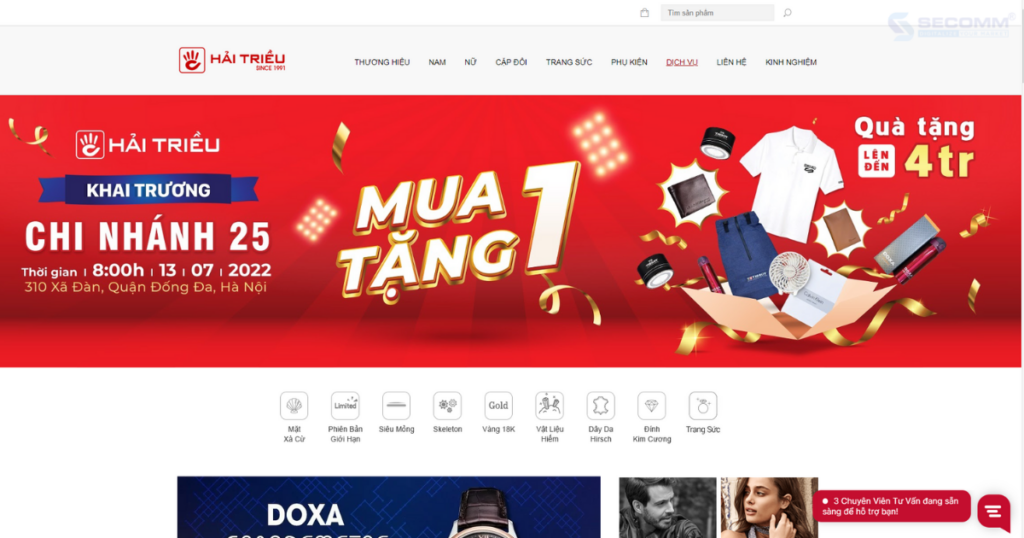
- Fashion field: Watches
- Website: https://donghohaitrieu.com/
- eCommerce platform: WooCommerce
- Traffic: 1.1M/month
- Rating: 807 (Vietnam), 51,641 (Global)
- Estimated value: $19.016
3. PNJ
The official name of PNJ is Phu Nhuan Jewelry Joint Stock Company, which was founded in 1988. PNJ has spent a long time developing a fashion eCommerce website to apply the omnichannel sales strategy. Because of the early adoption of eCommerce, PNJ has surmounted the tumultuous year of 2021 with net sales of over VND 19,547 billion, an increase of 12% over 2020.
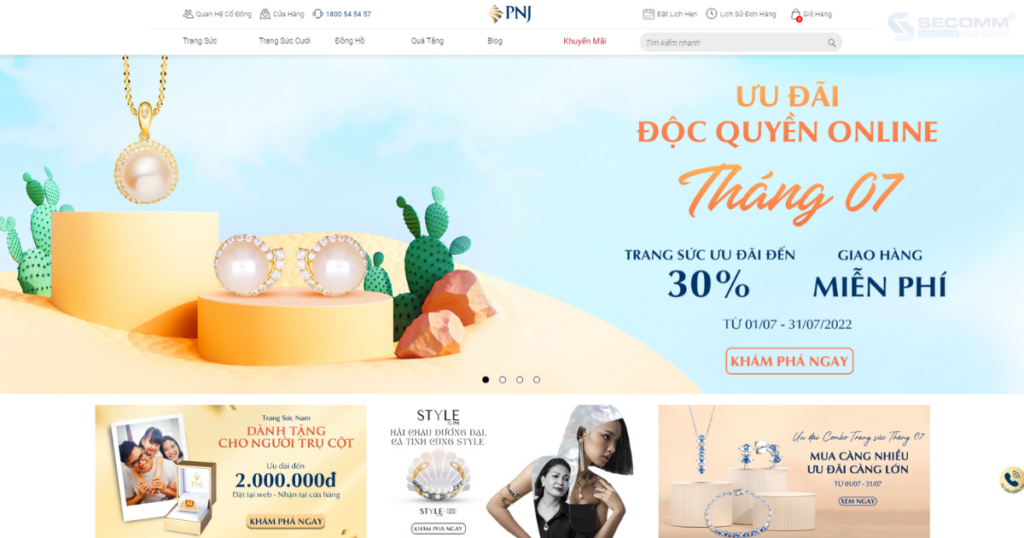
- Fashion field: Jewelry
- Website: https://www.pnj.com.vn/
- eCommerce platform: CS Cart
- Traffic: 926.9K/month
- Rating: 791 (Vietnam), 49,842 (Global)
- Estimated value: $21,007
4. Juno
Founded in 2005, Juno is a brand known for its line of women’s fashion shoes and bags. Juno saw the enormous potential of the e-commerce sector and invested early in technologies to make the online company more efficient. As a result, the eCommerce website of Juno is currently the highest-visited website in the fashion line of shoes and bags in Vietnam.
Juno has usually cultivated the clothes and accessories area to suit its clients’ increasingly broad consumer demands.
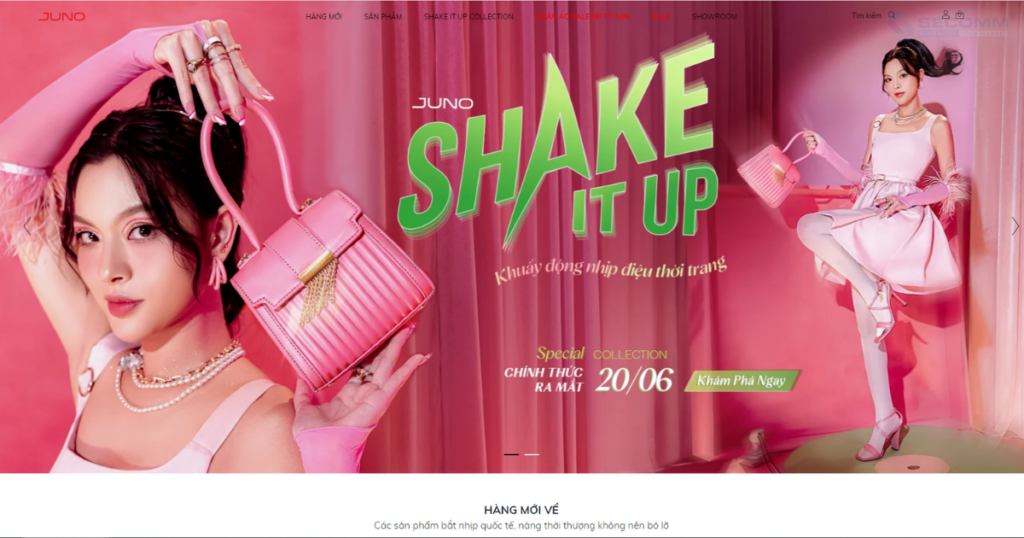
- Fashion field: Womenswear
- Website: https://juno.vn/
- eCommerce platform: Haravan
- Traffic: 899.3K/month
- Rating: 1,242 (Vietnam), 80,279 (Global)
- Estimated value: $20,688
5. Canifa
Canifa is a family fashion brand established in 1997, under Hoang Duong Service and Trading Joint Stock Company – a large fashion retailer in Vietnam. Canifa has built an eCommerce business with a reputation achieved in traditional fashion since 2012. Because of its long-term and sustainable eCommerce business strategy, this company opted to invest in establishing its own eCommerce website on the open-source platform – Magento and regularly upgrading this system to provide clients with the better eCommerce experience possible.

- Fashion field: Familyswear
- Website: https://canifa.com/
- eCommerce platform: Magento
- Traffic: 286.2K/month
- Rating: 2,537 (Vietnam), 155,488 (Global)
- Estimated value: $8,383
6. Hoang Phuc International
Hoang Phuc International (Hoang Phuc) was established in 1989 as a luxury fashion retailer of Kappa, Ecko Unltd, Superga, Replay, and Staple. This brand has decided to enter the eCommerce industry after three decades of using traditional strategy. Hoang Phuc has utilised and changed numerous platforms to create the successful eCommerce website that it is now. This business is currently employing the Magento platform – an open-source platform specialised in eCommerce.
This firm utilizes KOL and Livestream strategies to boost market penetration, besides constantly improving its own eCommerce website for selling apparel online.
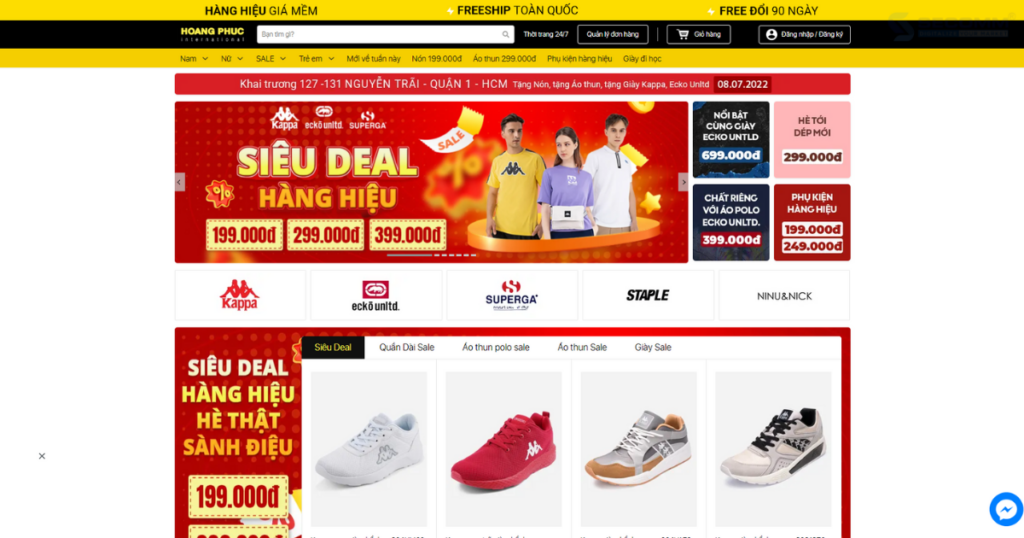
- Fashion field: Retail of luxury products
- Website: https://hoang-phuc.com/
- eCommerce platform: Magento
- Traffic: 258.0K/month
- Rating: 2,338 (Vietnam), 144,530 (Global)
- Estimated value: $19,895
7. Biti’s
Bitis began as a small factory in 1982 and has grown to become the market’s top shoe and footwear brand. However, when user behaviour changes and new “players” enter the market, this business appears to fall behind. After a long period of lagging, Biti’s new CEO, Vuu Le Quyen – the eldest daughter of Mr. Vu Khai Thanh – chose to change strategy, focusing on investing in eCommerce business model to accelerate and catching up with the market.
Bitis’s has made a dramatic recovery due to this new strategy, vying directly with worldwide brands such as Nike, and Adidas in the Vietnamese market after a number of years of losing market share.
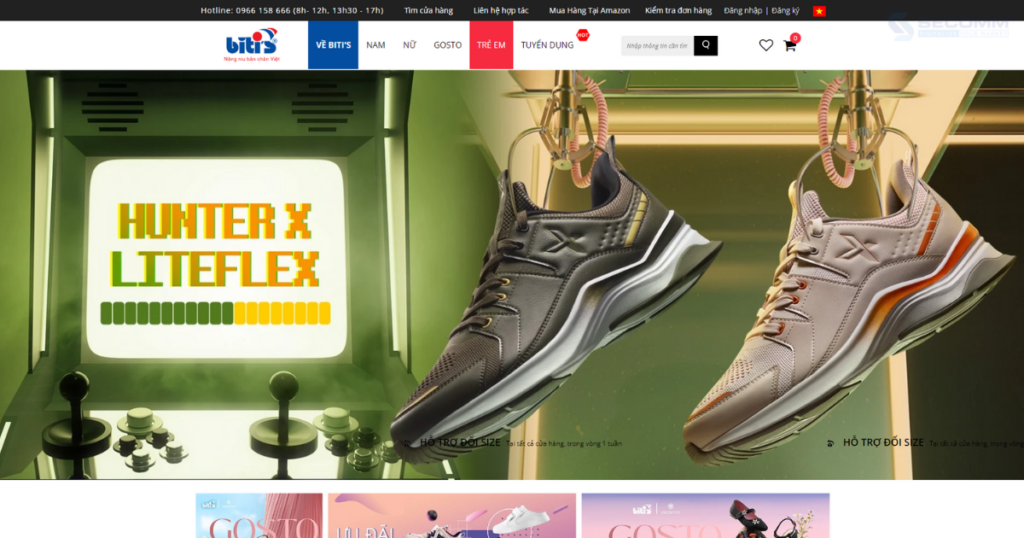
- Fashion field: Footwear
- Website: https://bitis.com.vn/
- eCommerce platform: Haravan
- Traffic: 206.6K/month
- Rating: 2,549 (Vietnam), 149,642 (Global)
- Estimated value: $8,966
8. Orchard
Orchard, which was founded in 2004, is a supplier of more than 200 luxury perfume brands from across the world. Orchard has implemented eCommerce promptly to tap the “gold mine” of this industry and become the No. 1 perfume retail brand in Vietnam. Orchard’s eCommerce website is now the favorite destination for customers who want to buy perfume online.
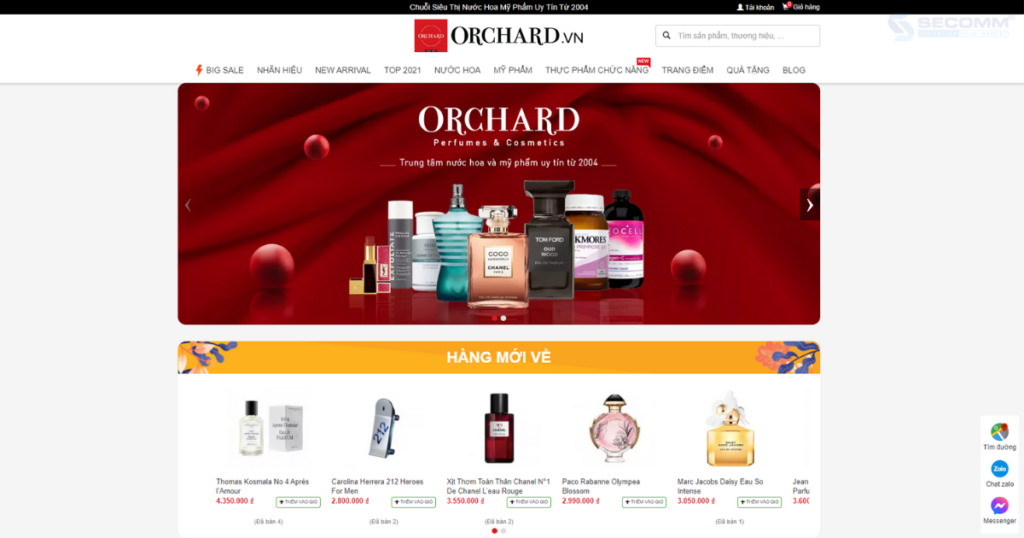
- Fashion field: Perfume
- Website: https://orchard.vn/
- eCommerce platform: WooCoomerce
- Traffic: 134.8K/month
- Rating: 6,800 (Vietnam), 372,708 (Global)
- Estimated value: $4,437
9. ONOFF
ONOFF was established in 2005 with the goal of providing daily comfort to everyone. ONOFF has advocated for adopting an eCommerce strategy by investing in building Magento websites like Canifa in 2016. As a result, the brand is gradually synchronizing on online and offline channels, with a customer loyalty rate of 80% maintained at all times, allowing ONOFF to more firmly believe in its goal of becoming the leading lingerie brand in Vietnam and a chance to conquering the ASEAN market in the next three years.

- Fashion field: Lingerie
- Website: https://onoff.vn/
- eCommerce platform: Magento
- Traffic: 79.5K/month
- Rating: 10,061 (Vietnam), 518,911 (Global)
- Estimated value: $9,289
10. Rabity
Rabity is a children’s fashion brand that was launched in 2000. Currently, Rabity is the sole Disney and Marvel partner with image rights for children’s fashion lines ranging from 0 to 14 years old. Rabity is pleased to have been the pioneer in deploying the first eCommerce for children’s fashion in Vietnam. Rabity is now present on all eCommerce channels and has its own eCommerce website.
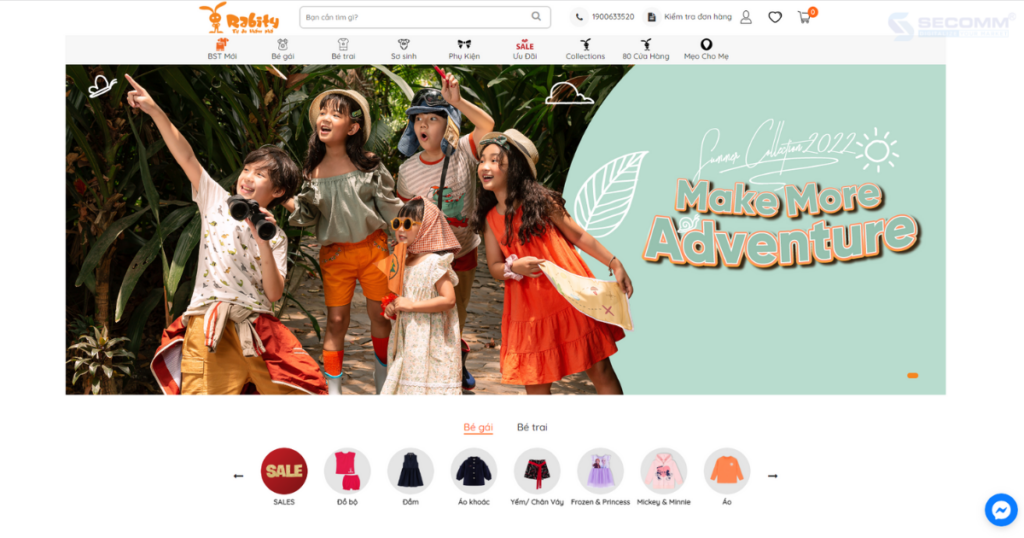
- Fashion field: Childrenswear
- Website: https://rabity.vn/
- eCommerce platform: Haravan
- Traffic: 12.3K/month
- Rating: 43,904 (Vietnam), 1,972,408 (Global)
- Estimated value: $15,335
Overall, fashion businesses are achieving several successes after developing their own eCommerce websites. However, the fashion eCommerce industry needs careful consideration of tactics to take the most successful actions in the short term and in the long run. Of course, to do that challenging task, fashion companies must find a well-known or build skilled IT team.
 2
2

 5,386
5,386

 0
0

 1
1

FASHION ECOMMERCE 2022: POTENTIAL, ADVANTAGES & CASE STUDIES
eCommerce has become an essential business model that fashion brands must utilize not only to survive during the COVID-19 pandemic but also to assist companies in adapting to changing customer behavior, providing competitive advantages for future breakthroughs.
As a result, fashion eCommerce has become a crucial business trend for many fashion businesses today, from start-ups to “giant” corporations.

1. The potential of eCommerce in the fashion industry
According to Statista, the compound annual growth rate (CAGR) of the fashion eCommerce market is predicted to be 14.2% from 2017 to 2025. The CAGR is forecast to reach a value of USD 1 trillion by 2025, in which the US market accounts for about 20%, equivalent to 204.9 billion USD.
In the Vietnamese market, fashion eCommerce is the second most important sector, just after eGrocery (The Vietnam eCommerce White Paper in 2021).
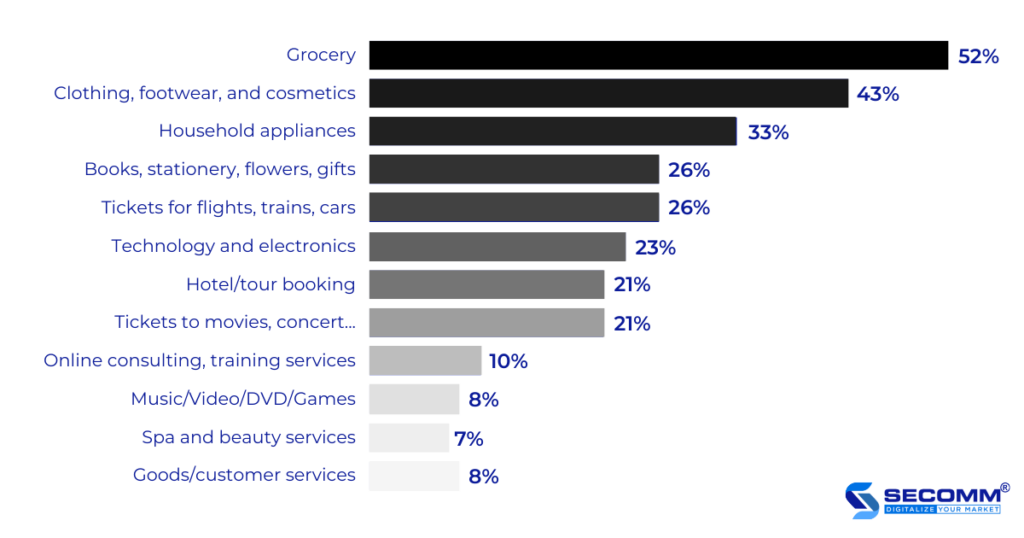
2. The advantages of implementing eCommerce in the fashion industry
2.1. Increase the breadth of your business
The use of eCommerce will provide fashion firms with a new sales channel, along with offline commercial activity in showrooms. For geographical factors, eCommerce transcends place and time to allow customers to purchase whenever and wherever they choose.

Simultaneously, eCommerce is a prominent avenue for reaching customers, particularly in the sphere of fast fashion for women. Marketing activities such as Livestream, Shoppertainment (Shopping with entertainment), Affiliate, and so on are more effectively carried out, leading to the extension of the commercial scope for enterprises.
2.2. Adapting to changing customer behavior
Following the COVID-19 epidemic and the social distancing order, consumer behavior has shifted dramatically, with the transition from physical to online buying rising over time in all categories. In the fashion business alone, the percentage of online customers climbed from 18% to 48% in 2020–2021. As a result, it is critical for fashion businesses to implement eCommerce.
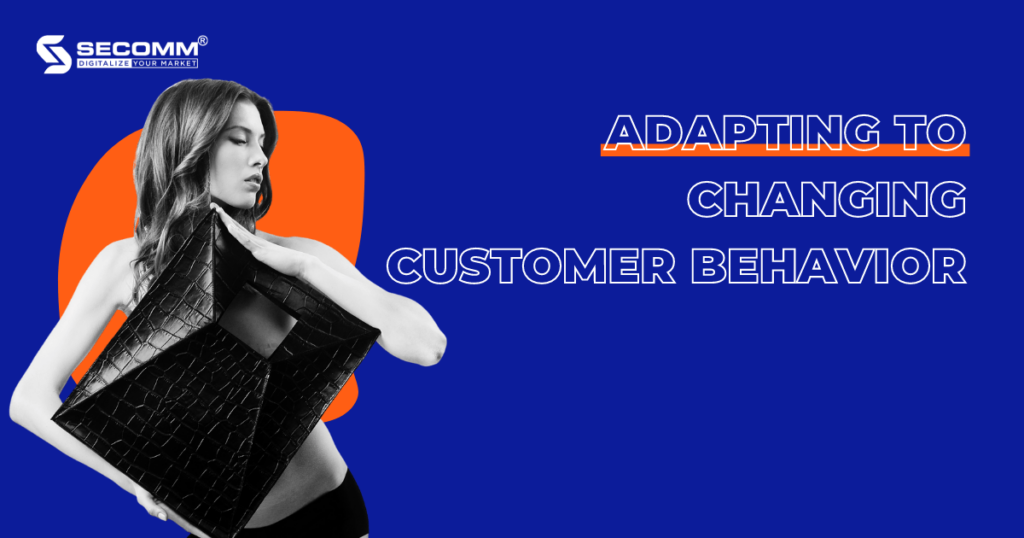
After the epidemic, consumer behavior altered drastically, such as waiting until D-Day to purchase items. Furthermore, by utilizing eCommerce technologies, organizations can follow, analyze, and synthesize the consumption behavior of each target group, something offline purchasing cannot accomplish. This ensures that businesses always have enough aggregated and forecasted data to implement business plans.
2.3. Improve the user experience
When technologies that improve user experience in e-commerce are used, customer purchases will be made faster.
Visual experiences such as photos, movies, virtual reality experiences, and so on provide customers with full product information and expertise, enabling a speedier purchasing process. VR / AR technology enables people to shop for garments, accessories, and shoes online in the same way they would in a store.
For example, the American Apparel company has used AR to show shoppers more product information, like detailed descriptions, availability, colors, and buyer reviews.

eCommerce allows businesses to tailor the experience for consumers by collecting, evaluating easily, and summarizing the consumption habits of each target group, often with the following features: Recommend products, Products seen, and so on.
eCommerce provides a seamless experience for customers across many channels such as social media (Facebook, Instagram, Tiktok, Zalo, etc), eCommerce marketplace (Shopee, Lazada, Tiki, Sendo, etc), eCommerce website, and mobile app.
3. Case study
3.1. Shein – The unicorn of the fashion eCommerce industry
Shein is a Chinese eCommerce site created in 2008 that specializes in apparel and accessories. With the motto “everyone can enjoy the beauty of fashion,” the company pushes to give consumers a diverse selection of product options. Shein is currently regarded as a fashion “empire” with a valuation of $ 100 billion – more than Zara ($ 69 billion) and H&M (23 billion) combined.

Shein focuses on the youthful client sector of Gen Y and Gen Z, who use the Internet often. As a result, this brand has used technical components to reach more consumers in an appropriate and exact manner.
Shein created an eCommerce system that included a website and a mobile app to target overseas markets such as Europe, America, Australia, and the Middle East. Shein then advocated Social Commerce, Ecommerce Marketing, Affiliate Marketing, KOC, and other tactics to improve brand awareness and engagement.
In 2021, Shein’s mobile app exceeded 7 million monthly active users in the US alone (Airnow Data), and the hashtag #Shein garnered more than 10 billion views on TikTok (Jing Daily). Revenue reached $15.7 billion in 2021, up 60% from 2020 ($9.8 billion). It can be seen that Shein is a clear example of the effective application of eCommerce to capture market share in the fashion industry.
3.2. Coolmate – The missiles in the realm of fashion eCommerce in Vietnam
Coolmate is a menswear startup that was established in 2019. Coolmate is a mix of the words “cool” and “mate,” which means that the brand’s major purpose is to be a fashion buddy for customers. After barely two years of operation, this company received a $500,000 funding call from Sharktank Vietnam.
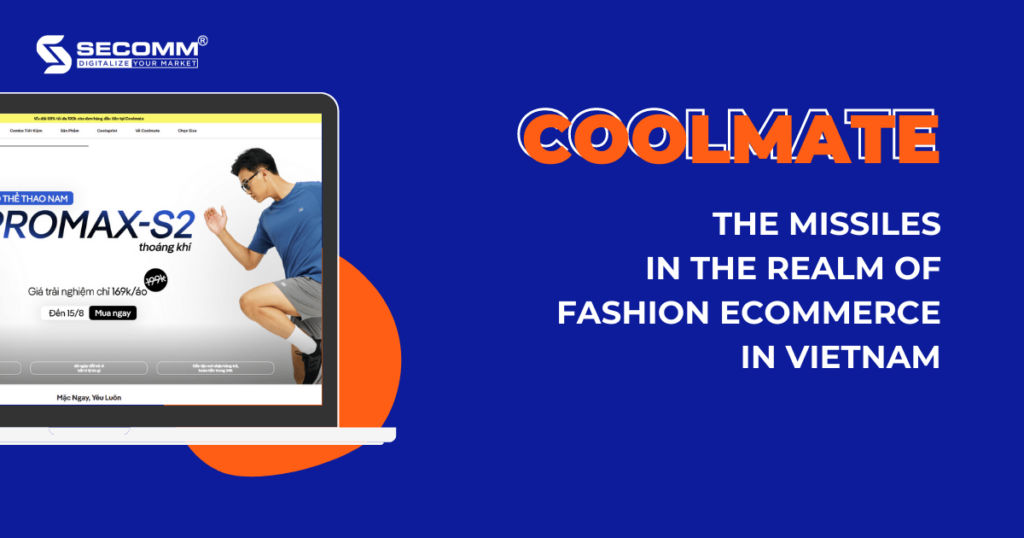
Coolmate utilizes the Direct to Customer Ecommerce (D2C eCommerce) model and concentrates on developing its own fashion website to provide a quick and cost-effective buying experience. At the same time, this brand prioritizes product quality, which is 100% made in Vietnam and meets export standards at low costs. Furthermore, to implement e-commerce faster, Coolmate advocates thoroughly apply the strategy of Ecommerce Marketing, Affiliate Marketing, Email Marketing, etc.
Aside from the $500,000 agreement for a 12.5% interest, 2.5% of the consultancy shares pledged, this fledgling business has other noteworthy statistics. Coolmate’s sales will reach VND 139 billion in 2021, up 3.5 times from 2020, with revenue expected to reach VND 440 billion in 2022 and an IPO (Initial Public Offering) by 2025. In general, eCommerce has considerably contributed to Coolmate’s development, as well as providing the groundwork for fashion businesses to follow to grow by market trends.
3.3. Yody – The behemoth chose to compete in the fashion eCommerce race
Yody (previously Hi5) is a family apparel label that was founded in 2014. To provide Vietnamese fashion goods made of high-quality materials to customers in various regions of Vietnam and throughout the world. Yody now employs over 700 people and has 90 outlets around Vietnam.
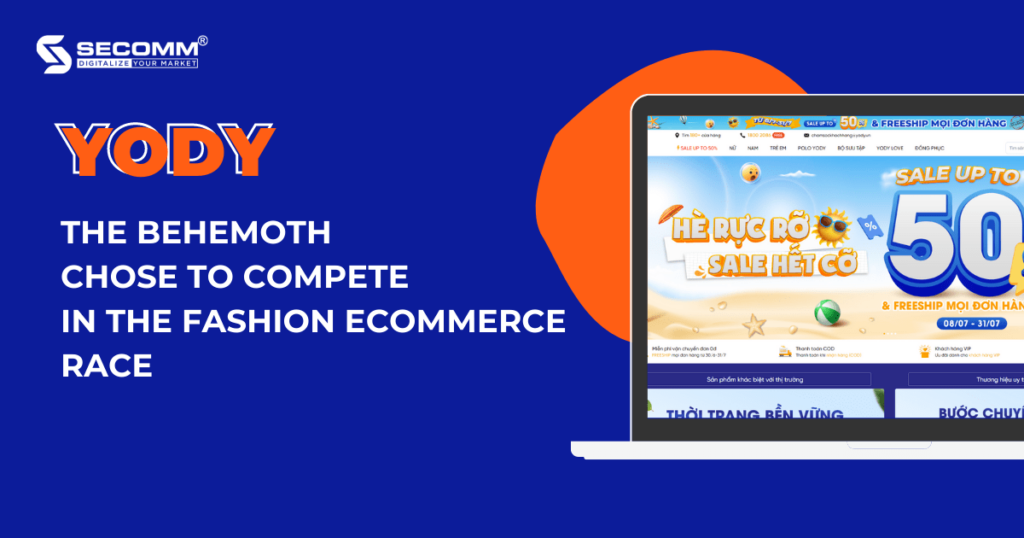
This fashion brand prioritizes the “tripod” of human resource development, product quality, and technology investment. Yody focuses on talent recruiting and culture training to engage employees in human resource development. In terms of products, Yody designs for comfort and convenience, and can be utilized in various situations, such as going to work, going out, attending meetings, and so on.
Regarding technology, Yody focuses on implementing an online sales strategy across Omni-channel such as eCommerce marketplaces, an eCommerce website, Facebook, Livestream, and so on to compete in the eCommerce race, as well as adapting to changing consumer behavior.
In 2016, Yody was selected as one of the ten outstanding young start-ups in Vietnam. By 2021, Yody’s physical sales will have dropped by 65%, but the internet segment has increased by more than 10%. Therefore, the company continues to aim to increase online revenue by 20% in the next year.
In a nutshell, how to apply fashion e-commerce will depend on the size and strategy of each company, but eCommerce is a prerequisite for successful business in this industry.
 2
2

 4,061
4,061

 1
1

 1
1
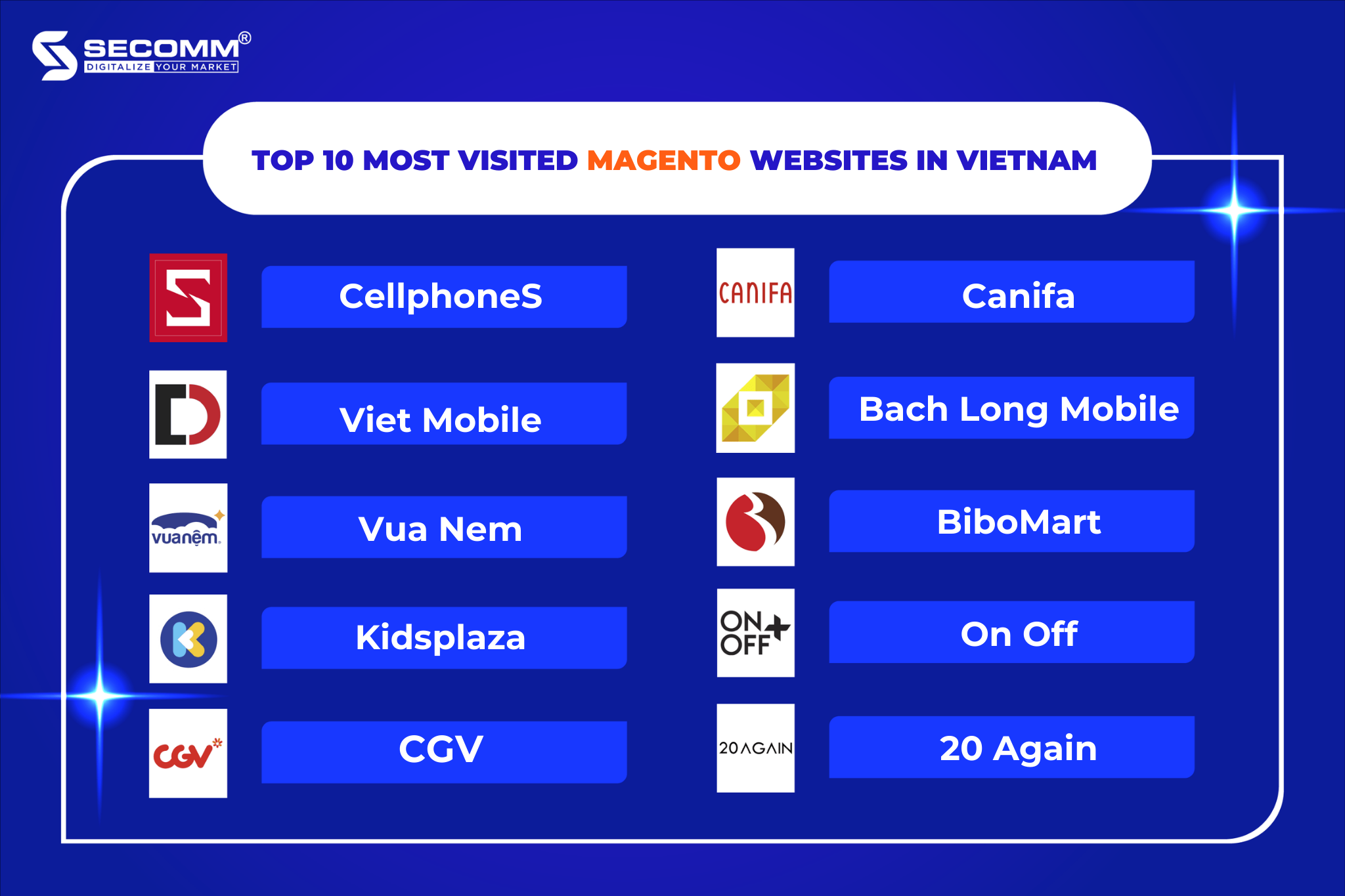
TOP 10 MOST VISITED MAGENTO WEBSITES IN VIETNAMESE MARKET
Magento is the leading open source eCommerce platform, powering over 186,000 websites worldwide. However, this platform has not been widely used in Vietnam, particularly among the community of new businesses entering the eCommerce market.
What is the Magento platform?
Magento is an open-source eCommerce platform written in the PHP programming language. Magento currently has two versions: Magento Open Source (free) and Magento Commerce (paid).
Why should businesses develop eCommerce websites on the Magento platform?
Inheriting outstanding advantages of open source eCommerce platform:
- Magento has a comprehensive set of features, ranging from basic to advanced, to serve all types of businesses, including B2C, B2B, and B2B2C eCommerce models.
- Customizability and extensibility make editing, building new functionality, and upgrading your eCommerce system easier.
- A diverse ecosystem and global technical support community provide diverse and continuous solutions, comprehensively and quickly resolving many eCommerce problems.
- High security, particularly for the administrator account, so that businesses can control data and reduce risks from website system transactions.
Top 10 most popular eCommerce websites in Vietnam using Magento
CellphoneS
In Vietnam, CellphoneS is a well-known retail system for technological products. The company is currently operating in Ho Chi Minh City, Hanoi, Binh Duong, Hai Duong, Hai Phong, Bac Ninh, Vinh Phuc, Thai Nguyen, and Vung Tau.
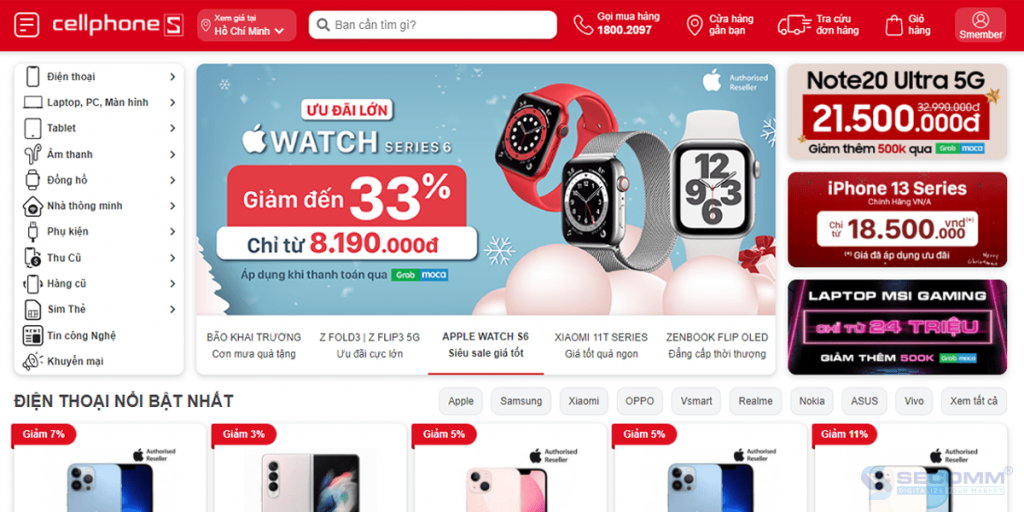
- Website: https://cellphones.com.vn/
- Traffic: 9.08M/month
- Expected online sales revenue: $49K+
- Expected website investment cost: $500+
- Used Version: Magento Open Source 1.9
Viet Mobile
Viet Mobile is a reputable electronics brand and a strategic partner of global technology corporations such as Apple, Samsung, Apple, OPPO, Sony, ASUS, and others.

- Website: https://didongviet.vn/
- Traffic: 1.98M/month
- Expected online sales revenue: $45K+
- Expected website investment cost: $1000+
- Used Version: Magento Open Source 2.3
Vua Nem
Vua Nem is a leading retail chain of mattresses, blankets, sheets, pillows and accessories with more than 100 stores spanning from North to South.

- Website: https://vuanem.com/
- Traffic: 1.44M/month
- Expected online sales revenue: $500+
- Expected website investment cost: $64K+
- Used Version: Magento Open Source 2.2
Kidsplaza
Kidsplaza is a big star in the mother and baby industry, with over 133 locations nationwide.\

- Website: https://www.kidsplaza.vn/
- Traffic: 816.17K/month
- Expected online sales revenue: $500+
- Expected website investment cost: $64K+
- Used Version: Magento Open Source 2.3
CGV
CGV, along with Galaxy, Lotte Cinema, BHD Star Cineplex, and CineStar, is one of the top five largest cinema clusters in the world and a major distributor and cinema cluster in Vietnam.
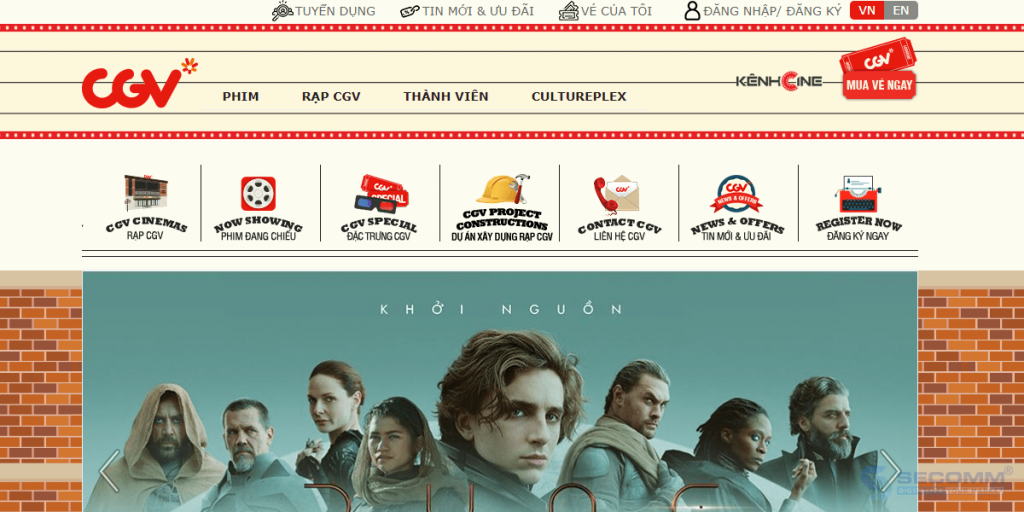
- Website: https://www.cgv.vn/
- Traffic: 674.80K/month
- Expected online sales revenue: $1.5M+
- Expected website investment cost: $2000+
- Used Version: Magento Commerce
Canifa
CANIFA is a fashion brand that specializes in designing clothes, accessories, and retailing casual wear for families. It is currently owned by the Hoang Duong Textile Group.
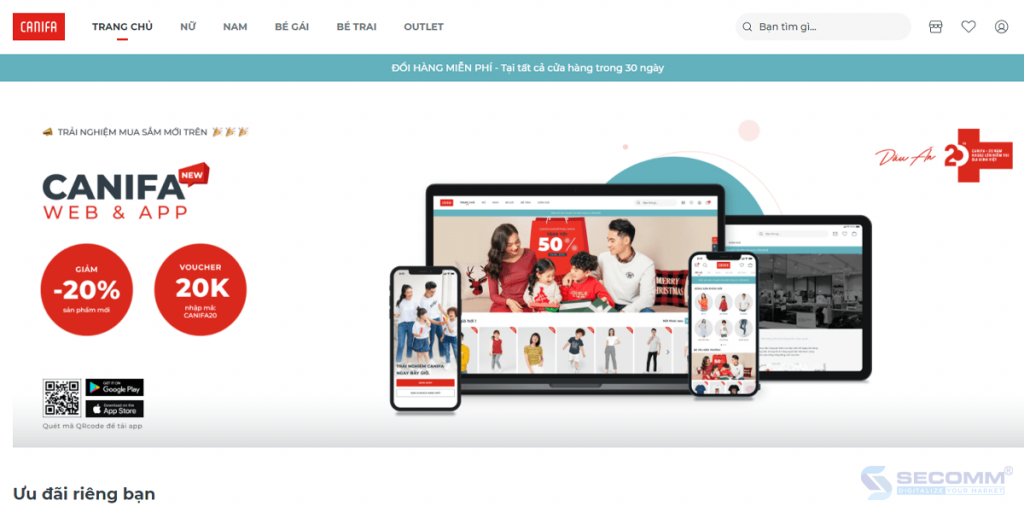
- Website: https://canifa.com/
- Traffic: 293.41K/month
- Expected online sales revenue: $156K+
- Expected website investment cost: $2000+
- Used Version: Magento Open Source 2.3
Bach Long Mobile
Bach Long is one of the popular retailers of smartphones, tablets, and technology accessories in Vietnam.

- Website: https://bachlongmobile.com/
- Traffic: 283.79K/month
- Expected online sales revenue: $47K+
- Expected website investment cost: $500+
- Used Version: Magento Open Source 1.9
Bibomart
Bibo Mart is a Vietnamese supermarket chain that sells and services to mothers and babies. Bibomart used eCommerce in 2019 to reach customers and expand its online business.
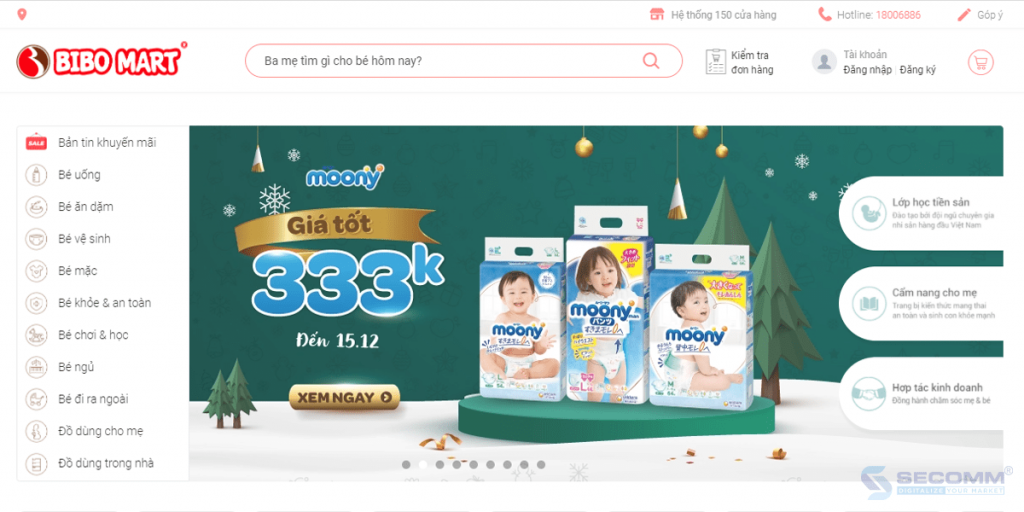
- Website: https://bibomart.com.vn/
- Traffic: 217.45K/month
- Expected online sales revenue: $1.5M/month
- Expected website investment cost: $2000+
- Used Version: Magento Open Source 2
On Off
On Off is a lingerie brand founded in 2005 to bring everyone comfort every day.

- Website: https://onoff.vn/
- Traffic: 162.29K/month
- Expected online sales revenue: $31K+
- Expected website investment cost: $250+
- Used VersionMagento Open Source 2
20 Again
20 Again is a women’s fashion brand with 3 main product lines: Office Wear, Dress Design, and Street Wear.
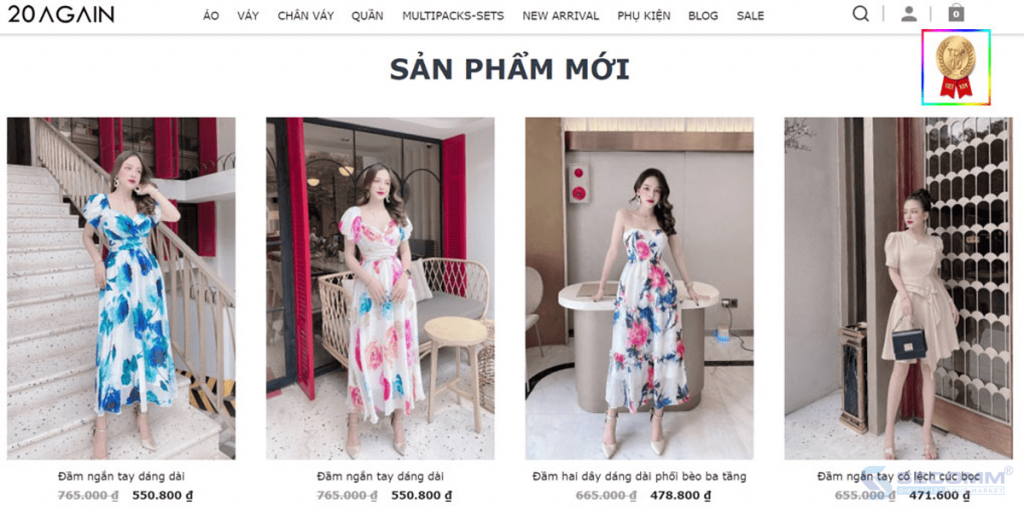
- Website: http://20again.vn/
- Traffic: 1K/month
- Expected online sales revenue: $24k+
- Expected website investment cost: $250+
- Used Version: Magento Open Source 2
Are you looking for the best Magento website development solution?
Contact SECOMM now for a free consultation on eCommerce development roadmap on Magento platform.
- Comprehensive understanding: Providing comprehensive eCommerce solutions from consulting, development, operation to eCommerce system growth.
- Expertise: Over 7 years of experience in implementing complex eCommerce systems for many customers from many countries (Australia, Singapore, USA, New Zealand, Denmark, Vietnam).
- Flexible schedule: The project’s time and progress can be adjusted to meet the specific needs of the business.
- Reasonable budget: Own a Magento website quickly with a reasonable budget, saving 80% for businesses.
 3
3

 3,539
3,539

 0
0

 5
5
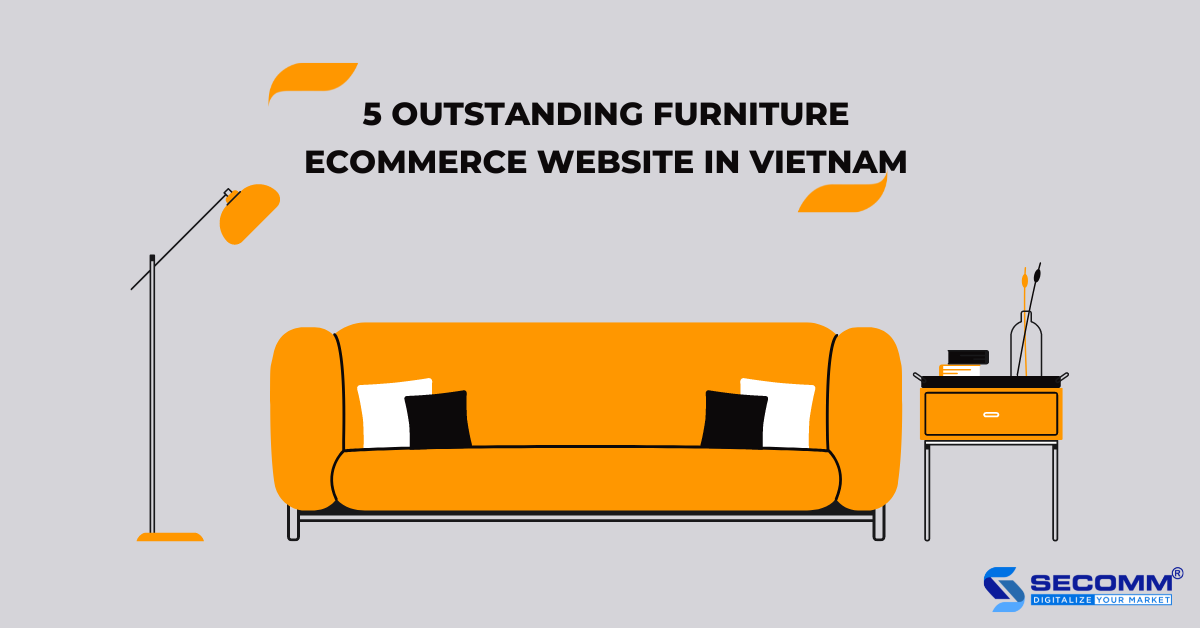
5 OUTSTANDING FURNITURE ECOMMERCE WEBSITE IN VIETNAM
Businesses may quickly detect a change in consumer behavior throughout the course of the pandemic as online purchasing steadily expands from basic necessities like food and medicine to a variety of other industries like fashion, wine, and furniture.
Also, customers’ awareness of a pleasant, modern, and healthy lifestyle has grown dramatically, which has given the furniture business a chance to go online and serve as a catalyst for Vietnamese eCommerce furniture to see breakthrough growth.
Realizing the great potential of this field, Vietnamese furniture enterprises have been embarking on building an eCommerce website system, which is considered an important factor leading to the success of this modern business trend.
Baya
Initially founded in 2006 under the name Sieu Thi Noi That Uma, the business has only recently (in 2019) changed its name to Sieu Thi Noi That Trang Tri Baya.
Although the brand’s name has changed, its essential values haven’t. It still offers clients high-quality furniture with a clean, sophisticated, trendy design in a neutral tone, and each piece is beautiful in its own right.
Thanks to the wise investment in developing a professional eCommerce website with the Magento open-source platform with an attractive and user-friendly interface, Baya’s website currently receives more than 100,000 visits each month.
In order to give clients the best eCommerce experience, this furniture manufacturer is constantly improving the system.
In addition, the company demonstrated its awareness of market trends by creating an app called My Baya with a QR payment method and positioning it as one of the primary categories on an eCommerce website to draw consumers’ attention to the website.
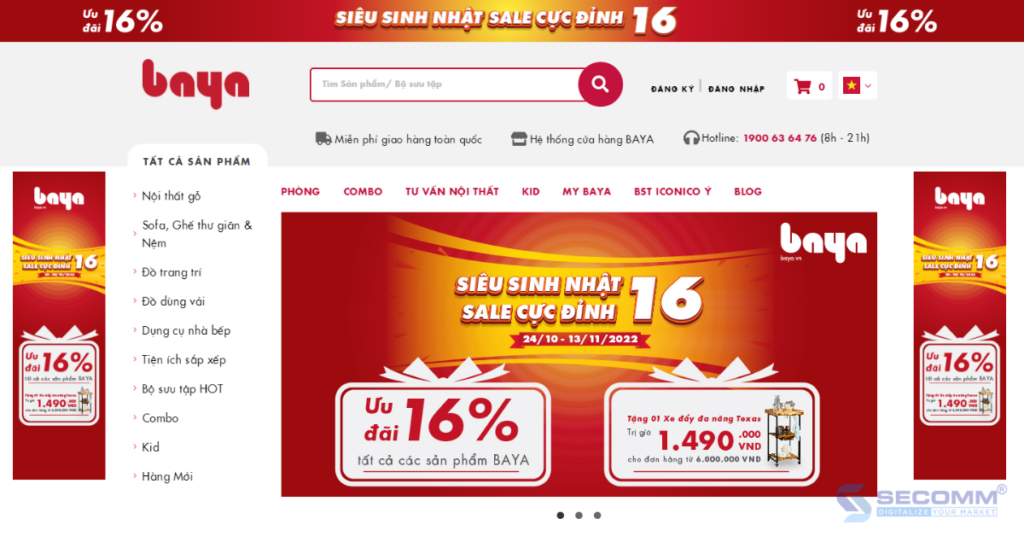
- Website: https://baya.vn/
- eCommerce platform: Magento
- Traffic: 103.9K/month
- Ranking: 11,388 (Vietnam); 526,185 (Worldwide)
Hoa Phat Furniture
With nearly 30 years of market experience and a wide range of clients, Hoa Phat Furniture is one of the top furniture suppliers and manufacturers in Vietnam.
All of Hoa Phat’s items are designed with a contemporary, opulent, and refined aesthetic in mind. In addition to a business strategy that is flexibly adjusted to the changes in the market, the company fully exploits the potential of eCommerce by building a professional and well-organized website on the BigCommerce platform.
From there, businesses increase their coverage and brand awareness on the Internet and reach more customers thanks to effective marketing methods.
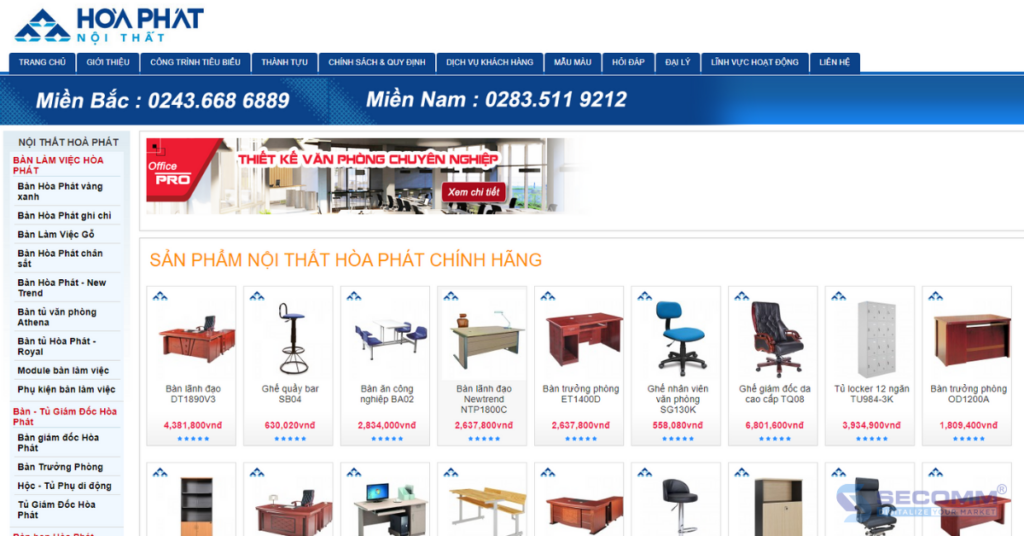
- Website: http://noithathoaphat.com.vn/
- eCommerce platform: BigCommerce
- Traffic: 59K/month
- Ranking: 11,855 (Vietnam); 545,292 (Worldwide)
Moho
The Moho furniture brand was established in March 2020 and is a subsidiary of Savimex, a company with over 35 years of expertise in the production and export of furniture. In order to fulfill the goal of sustainable development, Moho has kept offering clients furniture goods with affordable pricing and quality in accordance with international standards.
With more than 50,000 monthly visitors and a popular Haravan platform, Moho’s eCommerce website is well-liked by customers for their online buying experience.
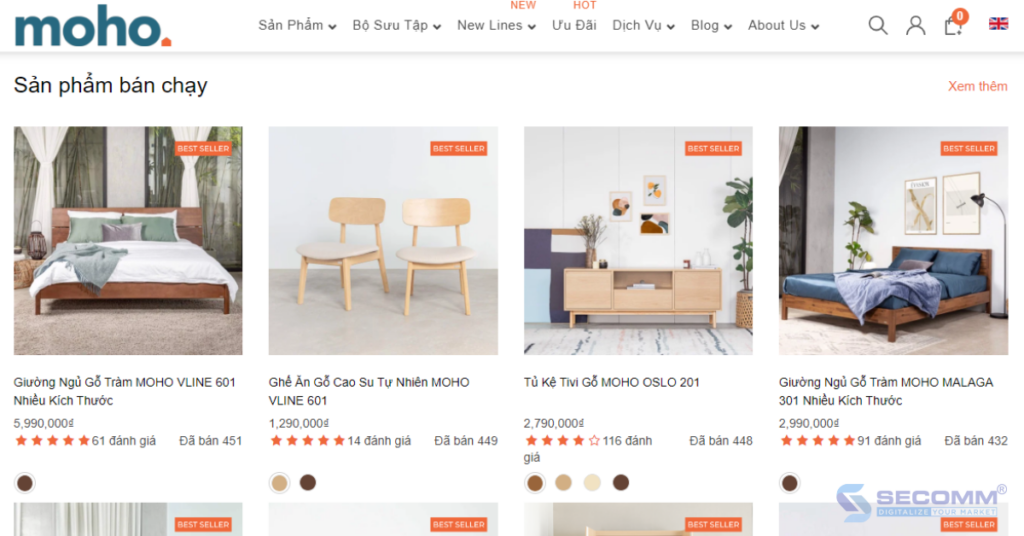
- Website: https://moho.com.vn/
- eCommerce platform: Haravan
- Traffic: 53.6K/month
- Ranking: 16,983 (Vietnam); 751,671 (Worldwide)
Cozy
COZY is a famous furniture brand present in the market since 1995 with high-class Italian-style designs. All products distributed by COZY are subjected to quality checks. With more than 25 years of establishment and development, COZY is one of the leading prestigious units in Vietnam in importing furniture from high-end brands from Europe.
In order to increase sales channels and reach a large number of potential customers online, COZY invested in developing an eCommerce website using the Shopify platform in addition to the showroom system dispersed around the districts of Ho Chi Minh City.
Because of the website’s elegantly crafted, opulent, and smart user interface, it receives an astonishing 45,000 visitors each month.
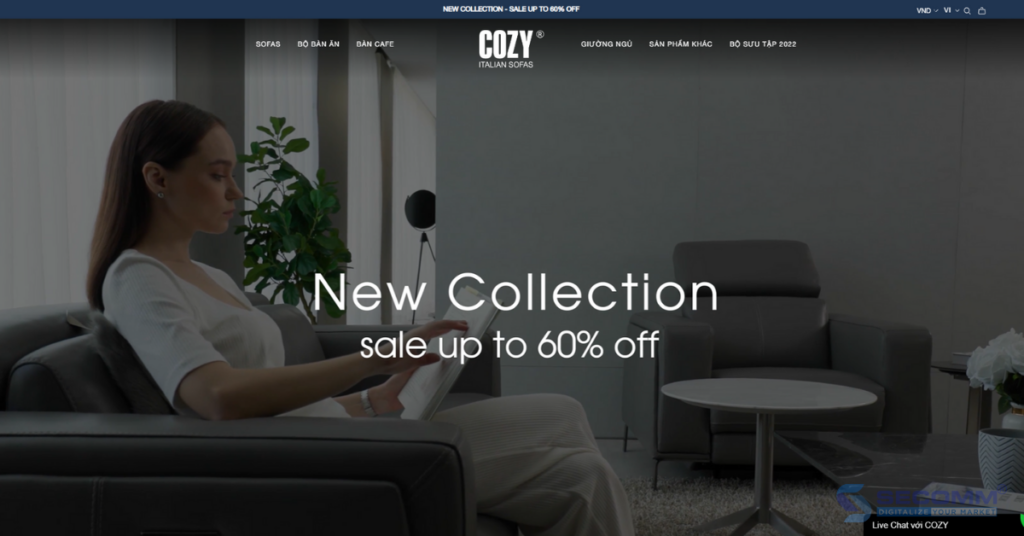
- Website: https://cozyliving.com.vn/
- eCommerce platform: Shopify
- Traffic: 45.3K/month
- Ranking: 23,596 (Vietnam); 1,033,514 (Worldwide)
Nha Xinh
Nha Xinh chooses a simple and intimate interior design style for each of the company’s products. The WooCommerce platform’s straightforward and user-friendly design of Nha Xinh’s eCommerce website’s interface amply illustrates this.
Furthermore, Nha Xinh’s website uses 360-degree technology to enable buyers to experience the company’s interior items from a distance in an accurate manner, providing information and a complete price list for each item from every angle of the room and product.
The eCommerce website now receives more than 40,000 visitors each month because of its painstaking attention to every last detail.
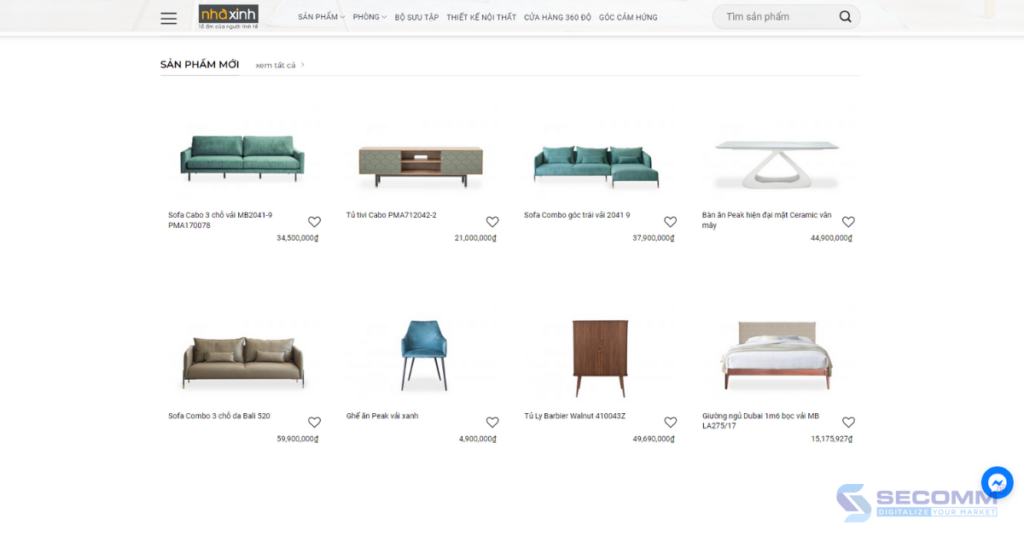
- Website: https://nhaxinh.com/
- eCommerce platform: WooCommerce
- Traffic: 41.1K/month
- Ranking: 15,415 (Vietnam); 696,229 (Worldwide)
Customers can save a ton of time and money when shopping online, especially when purchasing furniture. However, there are a lot of potential hazards associated with this type of business, particularly with regard to product quality and information security, and safety during the shopping and payment processes.
The furniture eCommerce sites discussed in this blog post are well-known destinations that have been active on the market for a long time and have serviced and satiated the wide range and expanding needs of clients.
These companies demonstrate their efforts to create the technological infrastructure that will enhance customers’ online shopping experiences, and they take priority on the development of a professional, well-invested supply chain that will expedite shipments while maintaining the quality of the goods until they are received by the customer.
When Vietnamese furniture businesses launch their own fully-functional eCommerce websites, professionalism, adaptability, and speed are the key success criteria.
Nevertheless, in order for the furniture eCommerce firm to succeed, business managers must carefully and comprehensively take into account the growing client wants and the continuously shifting market trends.
In particular, the task is to lay out a solid and methodical company plan so that the best short- and long-term actions can be taken. Completing that difficult task will take a lot of time and resources. As a result, many furniture companies opt for a more straightforward approach to the issue, enlisting the assistance of a highly qualified and dependable unit.
With many years of experience in successfully implementing eCommerce for many customers in many countries, SECOMM specializes in providing consulting services with comprehensive and professional e-commerce implementation solutions. , repertoires.
Contact SECOMM today for free support and advice.
 2
2

 3,671
3,671

 0
0

 1
1
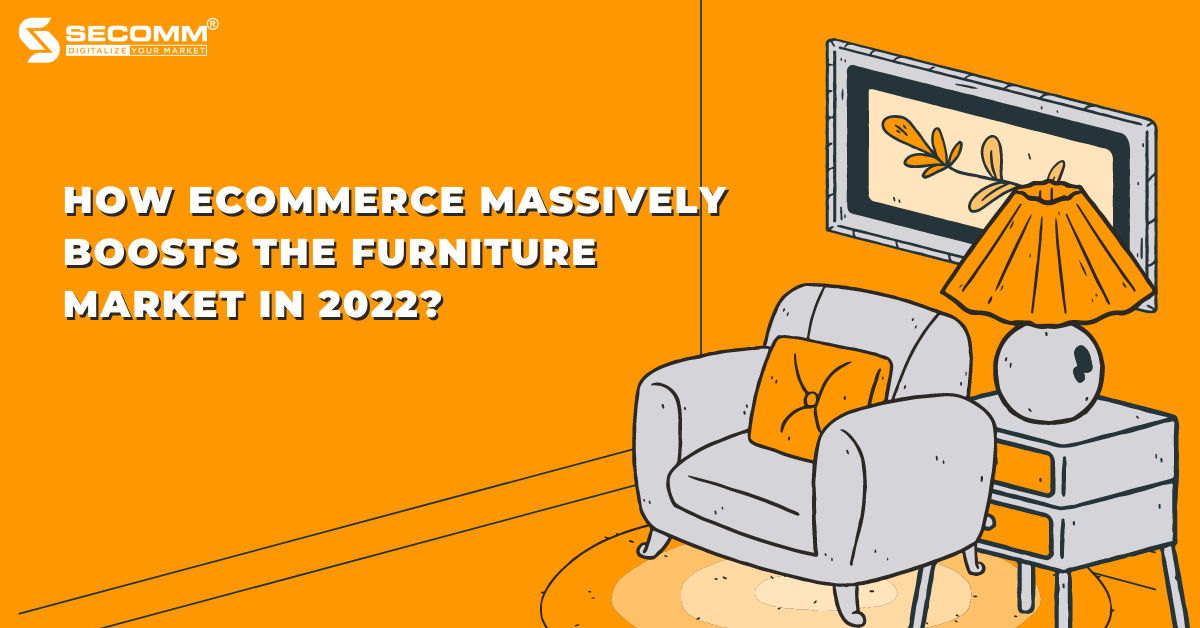
HOW ECOMMERCE MASSIVELY BOOSTS THE FURNITURE MARKET IN 2022?
The desire for home furnishings and design among consumers has significantly increased as life gets better and better. The majority of consumers still prefer to choose and purchase products in physical stores and showrooms, but online furniture shopping is an increasing tendency. Additionally, the impact of the Covid-19 pandemic on consumer purchasing habits has changed how people purchase, which has greatly aided the development of the furniture eCommerce market.
The enormous potential of eCommerce for furniture
BusinessWire estimates that the size of the furniture eCommerce market in 2021 was valued at USD 27.74 billion and that it would increase at a compound annual growth rate (CAGR) of 4.4% from 2022 to 2030 to reach USD 40.74 billion.
Recent findings made by Maddyness include the following intriguing details:
- The value of the worldwide furniture eCommerce market exceeds $200 billion.
- Online sales account for more than 90% of the growth of the furniture industry.
- According to estimates, 8 out of every 10 consumers who purchase furniture have made an internet purchase at least once.
- One in three consumers prefers to buy furniture online.
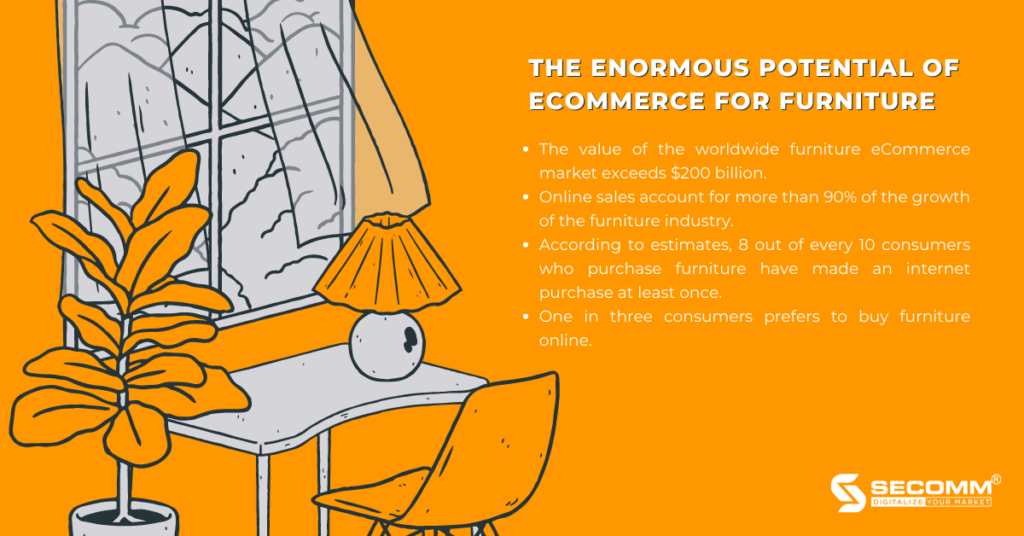
The advantages of eCommerce implementation for the furniture business
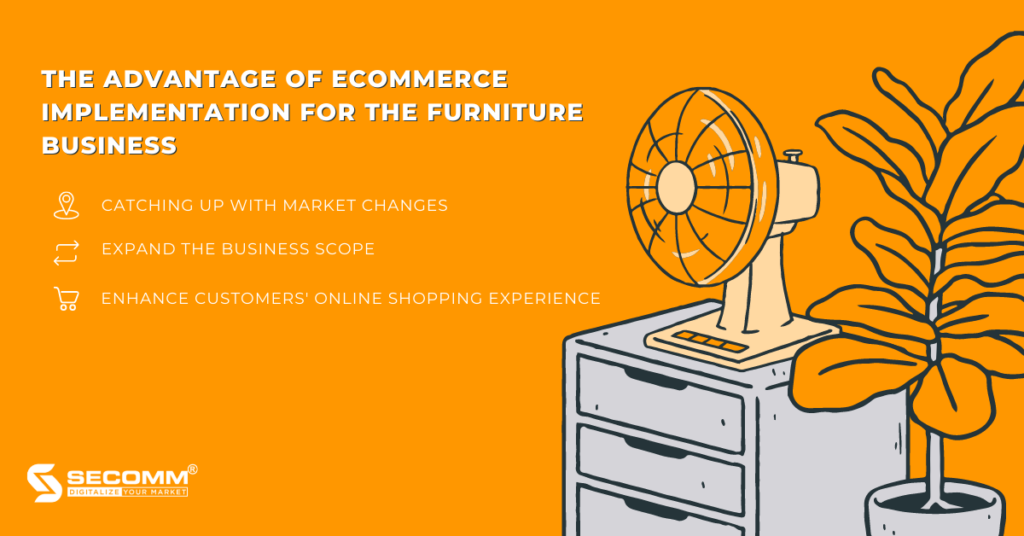
Catching up with market changes
The furniture sector has experienced a significant decrease in sales over the past few pandemic years, along with many other industries.
People are compelled to reduce their social interactions during the social withdrawal period. They now spend more time working, living, entertaining, and teaching at home. In light of the unpredictable changes of the pandemic, the necessity to clean and renovate the dwelling has therefore substantially increased.
Due to limits on leaving the house, online shopping at the time had become not only a need but also an urgent method of purchasing in place of in-person purchases. That serves as the springboard that gives eCommerce its spectacular development and propels it into other industries like fashion, grocery, wine, and even furniture.
These two elements highlight the “cake’s” enormous potential and aid many furniture companies in realizing and swiftly implementing eCommerce for market revolution and sustainable development.
Expand the business scope
Due to the Internet’s rapid expansion and the burgeoning online shopping trend, which is gradually replacing traditional offline shopping, the adoption of eCommerce will benefit furniture manufacturers by providing a new sales channel and attracting a big number of potential clients (at stores, and showrooms).
eCommerce implementation will also help to broaden the market for businesses by improving the circumstances for marketing campaigns to be more successful.
Enhance customers’ online shopping experience
When firms use technology to improve customer experience in eCommerce, furniture shopping will happen more quickly.
In the digital age, for instance, visual experiences from VR/AR technology, 3D product visualization, and 360-degree photography are very popular, gradually replacing in-store shopping while still being fully informed and realistic visualization of products, thereby increasing customer satisfaction during online shopping.
eCommerce enables businesses to quickly and effortlessly tailor the experience for customers by gathering, evaluating, and synthesizing the consumption behavior of each target group. Typically, this is done with the capabilities listed below: Products have seen, similar product recommendations, etc.
eCommerce provides clients with a seamless experience in addition to an intuitive one across a variety of channels, including social networks (Facebook, Instagram, Tiktok, Zalo, etc.), eCommerce platforms (Shopee, Lazada, Tiki, Sendo, etc.), eCommerce websites, mobile apps, etc.
The interesting story of big guys
IKEA – The iconic furniture retailer, enters eCommerce to boost online sales
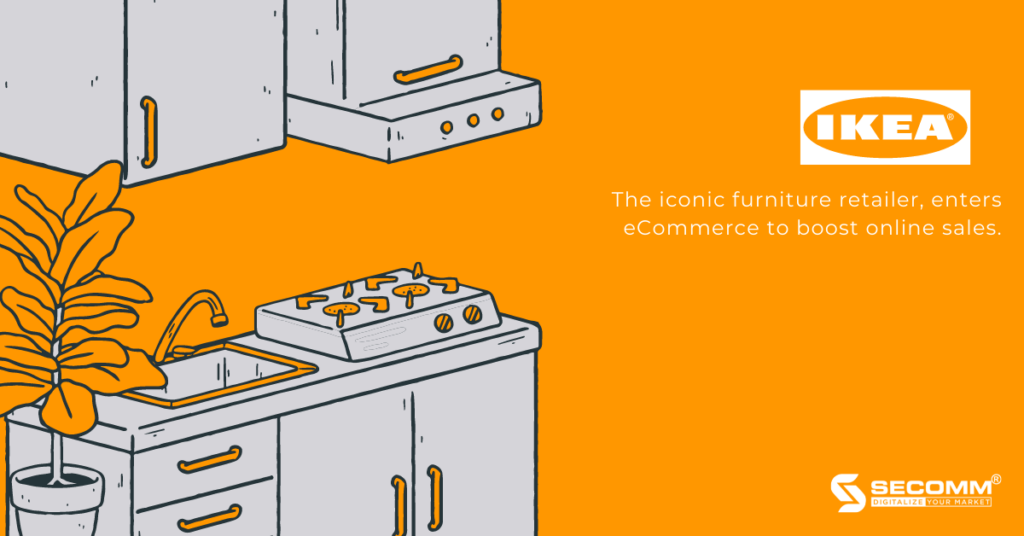
IKEA, or Ingvar Kamprad Elmtaryd Agunnaryd, is the world’s largest furniture retail enterprise and specializes in delivering minimalist-styled assembled furniture, household appliances, and accessories.
IKEA was established in 1943 in Sweden by Ingvar Kamprad, who started his business at the age of 17. IKEA swiftly gained global dominance with 392 locations across 48 nations.
With the goal of offering furniture with a lovely style and wide application while keeping the price low so that as many people as possible can purchase the goods. The majority of the departments, from marketing and sales to supply chain and warehouse, share this goal.
Everybody works together to keep IKEA’s “vital” competitive edge intact so that the company can publish catalogs with thousands of products offered at long-term stable prices.
Despite being the largest furniture retailer in the world, IKEA has lagged behind eCommerce trends, according to the Financial Times. This well-known retailer started “renovating” its sales technique only when it encountered numerous internet rivals.
The biggest barrier that makes it difficult for IKEA to adjust its previously successful business model is the maze-like arrangement of store layouts to create an engaging experience of sightseeing, interior shopping, or requiring customers to drive to the store and assemble the components to make their own furniture.
But IKEA has unimaginably succeeded in launching an e-commerce website by fusing cutting-edge technology with a well-organized marketing plan. In particular, IKEA specifically uses VR/AR technology, which is seen as a new eCommerce trend and is favored by many firms, to improve users’ online purchasing experiences.
IKEA thereby covers the sales void left by the prior on-site furniture business model, but the gap won’t truly be felt until the Covid-19 pandemic and social separation restrictions are in place.
From this point, IKEA expands its consumer base both online and offline, and sales are progressively encouraged to increase significantly.
Additionally, IKEA’s eCommerce website incorporates Instagram posts of photographs of IKEA furniture goods that consumers customize, share, and tag with the hashtag #IKEA.
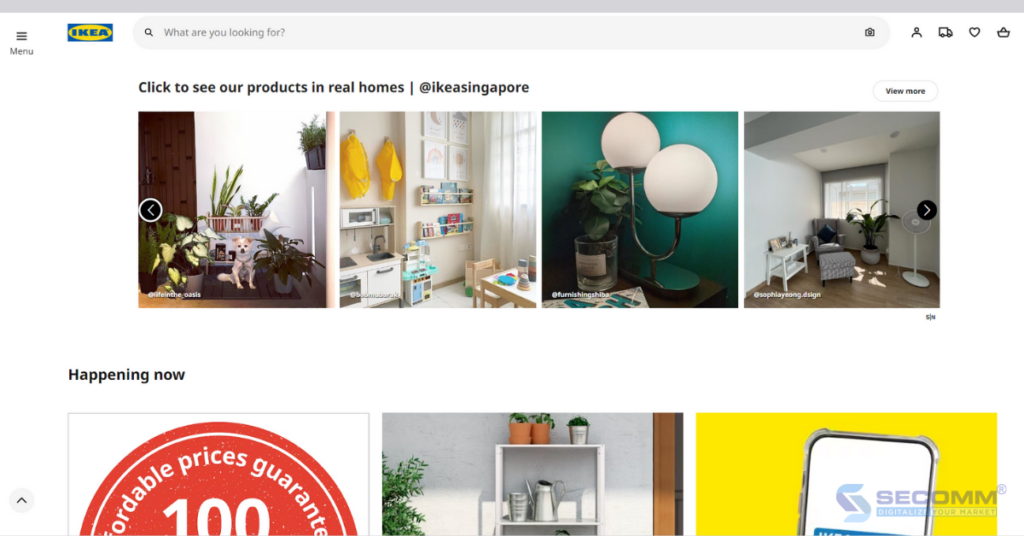
This not only helps this brand connect closely with Instagram users, increase its reputation and strengthen the loyalty of existing customers but above all, quick access to a large diverse customer base from the Internet in general and Instagram in particular thanks to the popularity and influence of this social network on young consumers.
Nha Xinh – The veteran warrior in furniture eCommerce
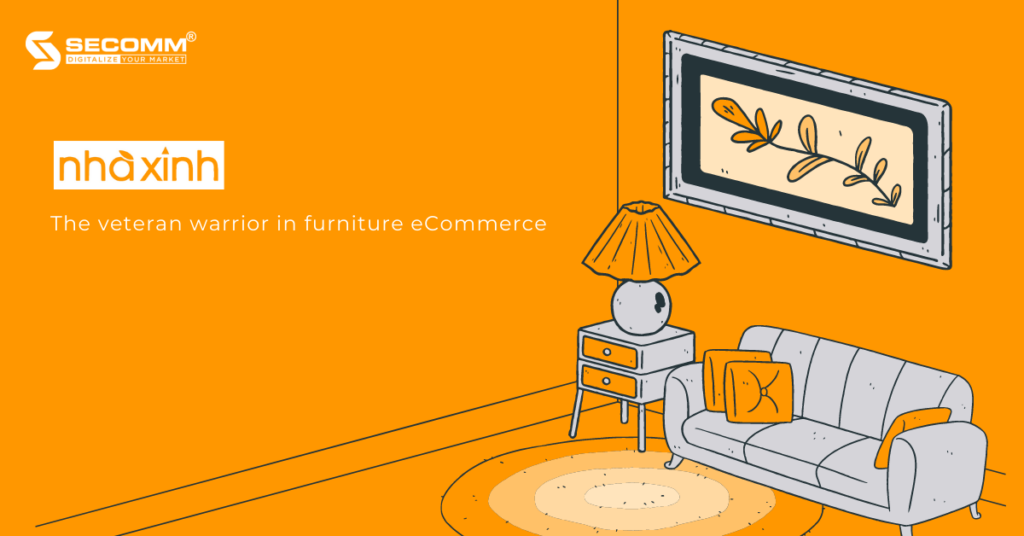
Established in 1999, Nha Xinh is a well-known furniture brand in Vietnam. It has two sizable showrooms, one each in Hanoi and Ho Chi Minh City.
As a manufacturer and supplier of living room, bedroom, dining room, and kitchen furniture with an Asian design aesthetic that favors coziness, friendliness, and simplicity above sophistication and luxury, Nha Xinh is a specialist in this field.
Nha Xinh’s website belonged to the “long-lived” row in the Vietnamese eCommerce village when it was created and launched in 2007, a period in which Vietnam was still getting used to utilizing the Internet to progressively integrate with the rest of the world.
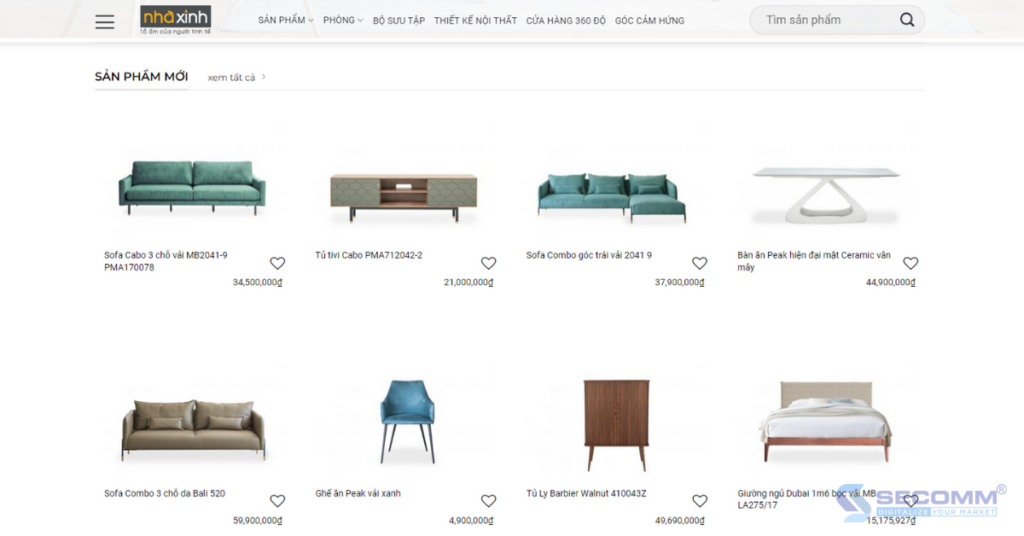
Nha Xinh’s eCommerce website has survived many years of market ups and downs while maintaining its inherent simplicity, intimacy, and sophistication.
Product categories are arranged clearly and harmoniously in each room to make it easy for customers to search, choose products that suit their needs, and get a sense of the room’s overall layout.
Customers can choose from a variety of options because the room’s layout is available with furniture and includes a detailed price. If they prefer, they can even select a combination of the interior and decor of the room without having to spend a lot of time figuring out how to combine each item because Nha Xinh already did it.
Additionally, Nha Xinh’s website has a unique section called “360-degree store” that uses 360-degree technology to let customers view the company’s interior products from a distance in an accurate manner from every nook and cranny of the room and every angle of the product, along with comprehensive information and price lists for each item.
Additionally, Nha Xinh’s “Inspiration Corner” catalog offers a wealth of thoughts and ideas to assist clients in designing their dream living space. Nha Xinh gives home design recommendations in a variety of styles, from elegant, and gentle to strong and personable depending on the individual’s preferences.
Therefore, Nha Xinh is more than just an eCommerce site that sells furniture; it is also a handbook that provides customers with never-ending design ideas.
Noi That Hoa Phat – The giant is committed to winning the eCommerce race
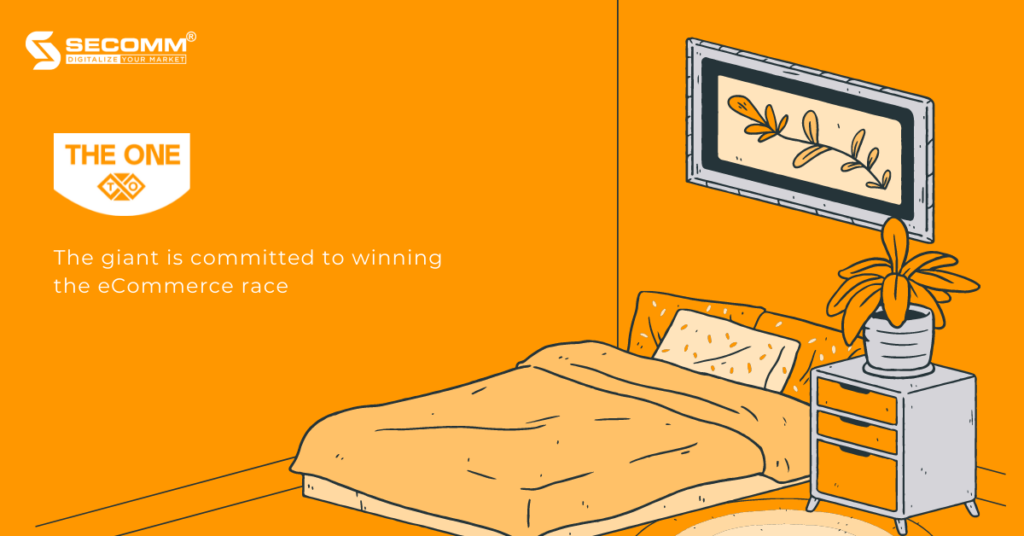
Hoa Phat Furniture was founded in 1995 and over the course of over three decades has made a positive impact on Vietnamese consumers’ perceptions of quality products and exquisite design while fulfilling a variety of needs for office furniture, home, household furniture, and medical furniture.
With a consistent growth rate of 20–25% each year, the brand is getting stronger and reaffirming its position as Vietnam’s top supplier and manufacturer of furniture.
When Hoa Phat Furniture changed its name to The One Furniture in the year 2022, it left a lasting impression on the industry. The brand name change is linked to adaptable changes in strategy. The company focuses on enhancing the stature, appearance, and image connected with the growth of the nation, helping to instill a variety of ideals into society.
Hoa Phat Furniture (now The One Furniture) invests extensively in technology infrastructure to streamline the production and supply process at the same time as it aspires to expand throughout the area and the world. One might say that The One Furniture has carried on the brand’s good core principles and improved upon them in order to better suit the current market trend.
One of Hoa Phat Furniture’s greatest successes to date is the effective use of 3D printing technology in production, which has helped the company create a number of new products like the Smart Safe; sofa and chair folding in the Italian style while also reducing production costs and speeding up prototyping and increasing product accuracy.
Hoa Phat Furniture concentrates on creating an eCommerce website to reach many potential clients that have a habit or preference for online buying, in addition to being adaptable and prompt with changes in strategy.
The firm creates websites using the WooCommerce framework, a well-known and dependable open-source platform used by many companies to implement eCommerce.
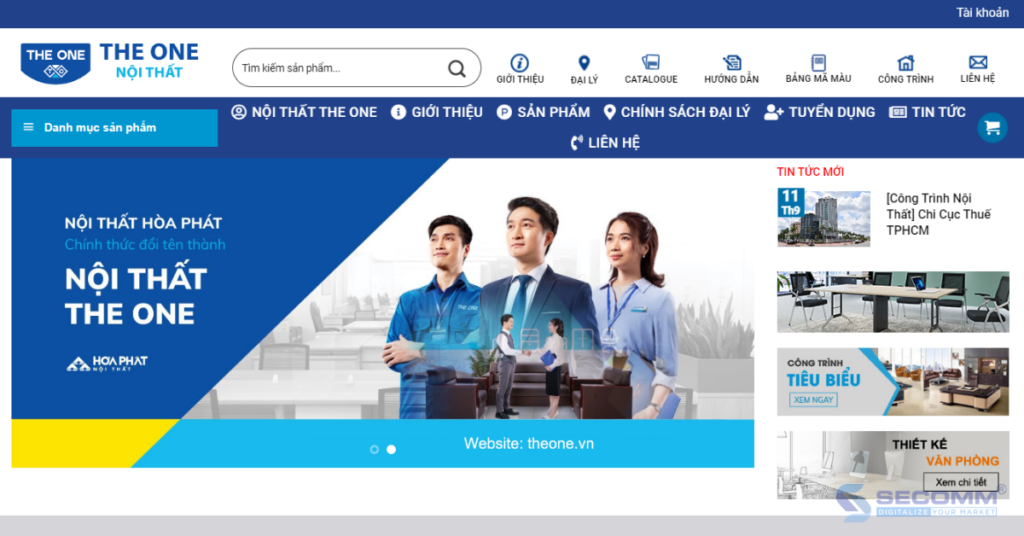
Compared to the previous version of Hoa Phat Furniture, The One Furniture’s new website (noithattheone.com.vn) features a more simplified, gorgeous, and contemporary interface (noithathoaphat.com.vn).
Additionally, the business supports the growth of well-known social media platforms like Facebook, Instagram, Youtube, and TikTok to broaden brand awareness, attract more customers, and enhance coverage.
Plus, the business offers a wide range of shipping and payment choices to accommodate the various needs of clients, making online buying at The One Furniture or Hoa Phat Furniture as convenient as it can be.
It is clear that the growth of the furniture market has been hastened by the speed at which eCommerce is developing.
Today, numerous local and international furniture companies participate in and offer the greatest shopping experiences to customers through the effective implementation of an eCommerce website, including IKEA (Sweden), Nha Xinh, and Hoa Phat Furniture (Vietnam).
From there, companies may quickly connect with a wider pool of Internet users and generate conversions through efficient marketing strategies.
However, business leaders need to carefully and comprehensively take into account the growing customer expectations and rapidly shifting market trends, not to mention specifically describe a systematic and precise business strategy for taking the most advantageous actions in the short and long term.
Completing that difficult task will take a lot of time and resources. As a result, many furniture companies opt for a more straightforward approach to the issue, enlisting the assistance of a highly qualified and dependable unit.
SECOMM has many years of expertise in effectively executing eCommerce for numerous customers in various countries. We specialize in offering free consultation services with qualified eCommerce implementation solutions.
Contact us right away for free counsel and assistance.
 2
2

 2,503
2,503

 0
0

 1
1
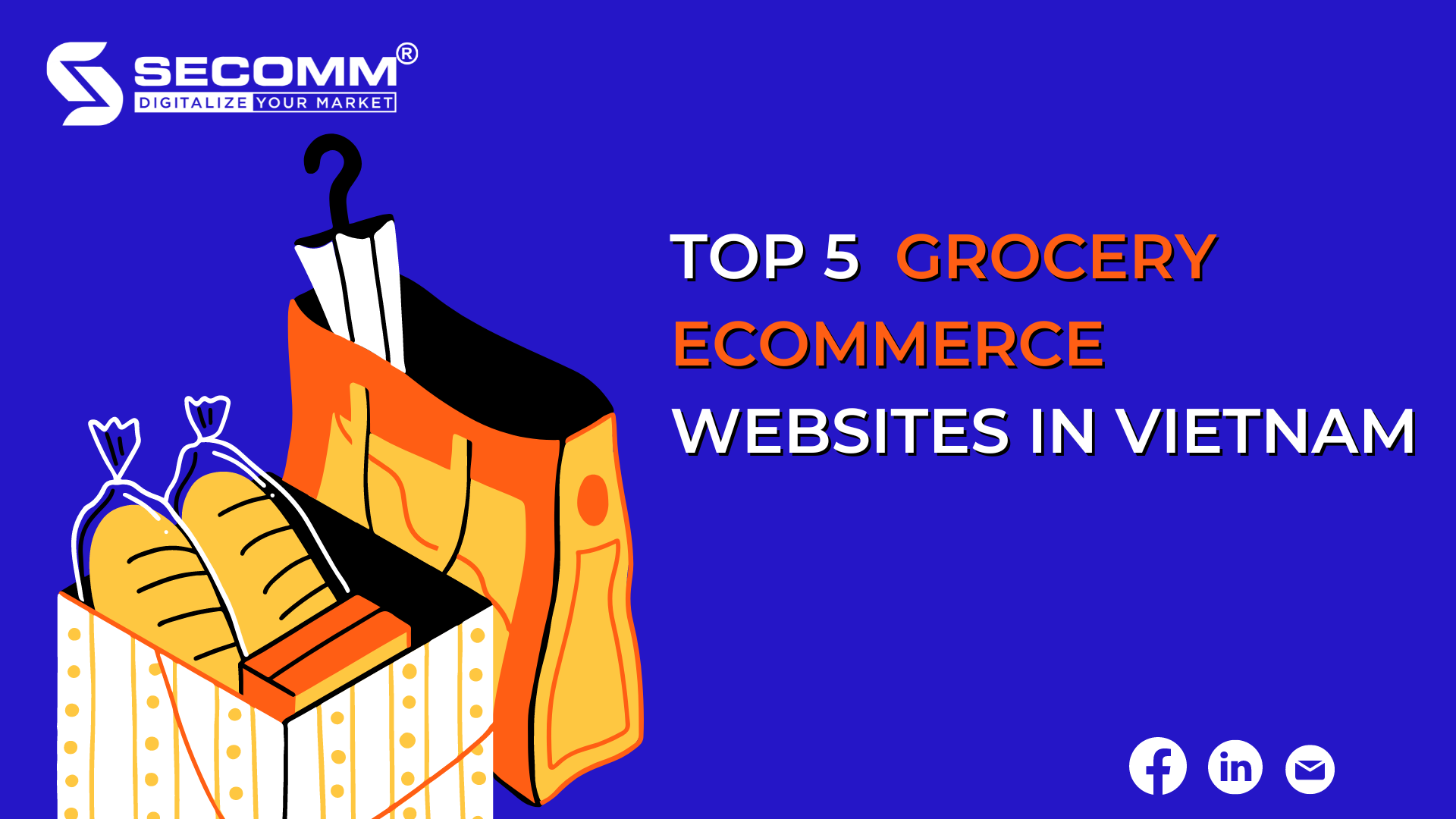
TOP 05 GROCERY ECOMMERCE WEBSITES IN VIETNAM
Grocery eCommerce is a trend in eCommerce that allows customers to buy goods online. This is regarded as the leading industry in the eCommerce market, particularly in Vietnam. According to an iPrice report, when people began staying at home to avoid the Covid-19 epidemic, traffic to websites specializing in the grocery business increased 45% faster than before. This trend remained stable after the social distancing was reduced, increasing by 10% at the end of the year. Online grocery is the only category that has seen consistent growth throughout the pandemic, with search demand continuing to rise.
There are some popular grocery eCommerce websites in Vietnam can be mentioned as:
Bach Hoa Xanh
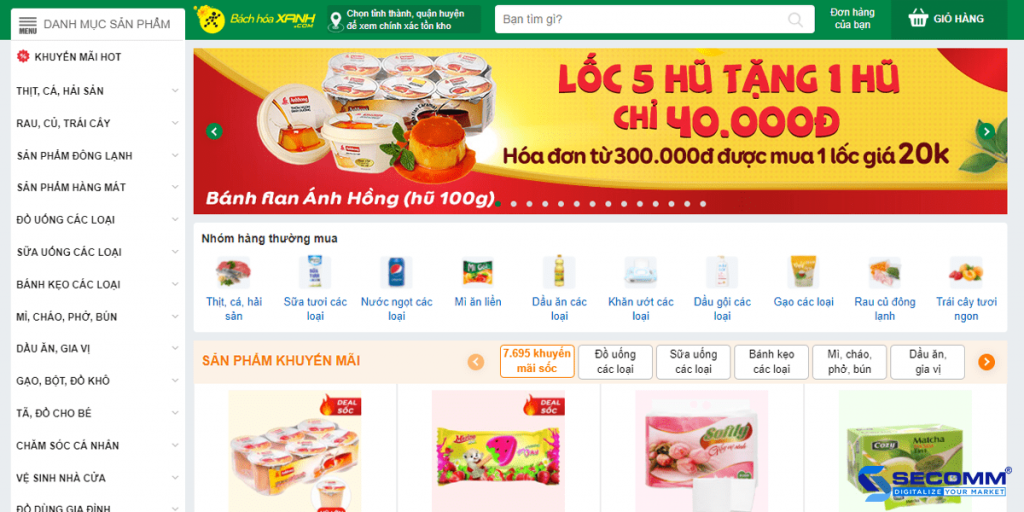
Bach Hoa Xanh is one of the most popular grocery store chain owned by Mobile World Joint Stock Company that specializes in selling fresh food and necessities. Bach Hoa Xanh currently operates nearly 2,000 stores in the South, East, and South Central provinces. This is the most visited website in the top five most visited websites in the Vietnam market, behind only the top four eCommerce platforms today, namely Shopee, Lazada, Tiki, and Sendo (According to iPrice).
– Website: https://www.bachhoaxanh.com/
– Traffic: 1.1M/month
WinMart

WinMart is a supermarket system and grocery store chain purchased by Masan Group from Vingroup. This brand was more commonly known as Vinmart at that time.
– Website: https://winmart.vn/
-Traffic: 209.5K/month
Organica
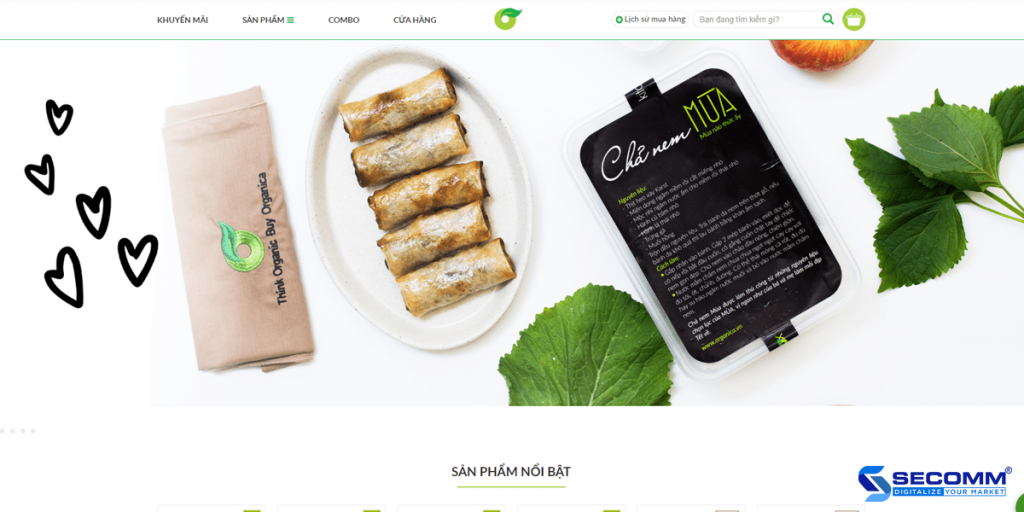
Organica is a natural and non-GMO certified organic food development and distribution system.
– Website: https://www.organica.vn/
– Traffic: 27.2K/month
Farmer’s Market
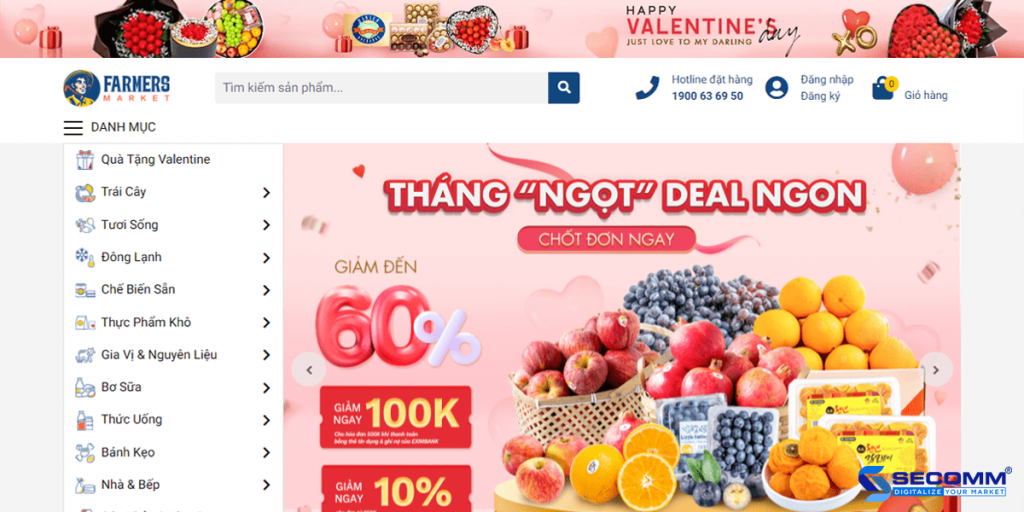
Farmer’s Market is a fresh food chain store brand managed by LARIA Trading Co., Ltd. To provide a seamless shopping experience O2O (online to offline), the company has built an omni-channel retail system serving over 4,000 customers daily.
– Website: https://farmersmarket.vn/
– Traffic: 17.5K/month
Annam Gourmet
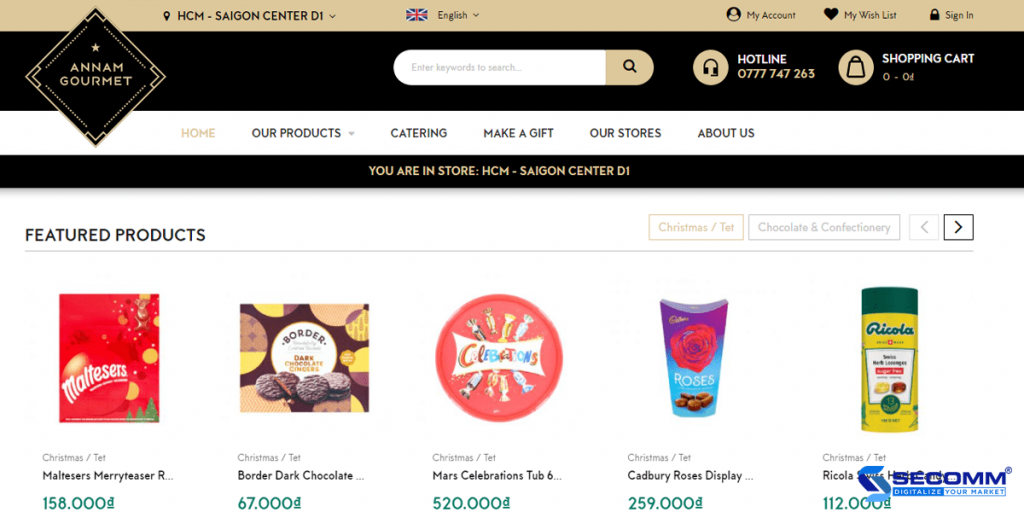
Annam Gourmet arose from the two Annam Group founders’ deep love of European cuisine. Annam Gourmet chain stores have been successfully operating in the Vietnamese market for over 20 years, offering high-quality imported product lines such as high-end food, wine, beverages, and cosmetics.
– Website: https://shop.annam-gourmet.com/
-Traffic: 8.7K/month
Grocery eCommerce Solutions
With a 200% annual growth rate, the future potential of grocery eCommerce in the Vietnamese market is undeniable (according to Statista). There are numerous opportunities in the eGrocery industry. Recently, many challenges have arisen, necessitating careful consideration of tactics by business managers in order to take the most effective steps.
The eGrocery businesses have opportunities and challenges, requiring business managers to consider tactics to take the most effective steps. Finding a partner is tricky and building an in-house team is tough. Businesses must incur significant opportunity costs and time to reach the goal.
Our company – SECOMM has been partnering with many big enterprises such as An Nam Group (Vietnam), Jasnor (Australia), and Changi Airport Group (Singapore). We are aware of the challenges and worries faced by firms while developing an e-commerce website system.
Get in touch with us now for FREE eCommerce consultancy and solutions in eGrocery businesses.
 2
2

 4,612
4,612

 0
0

 1
1
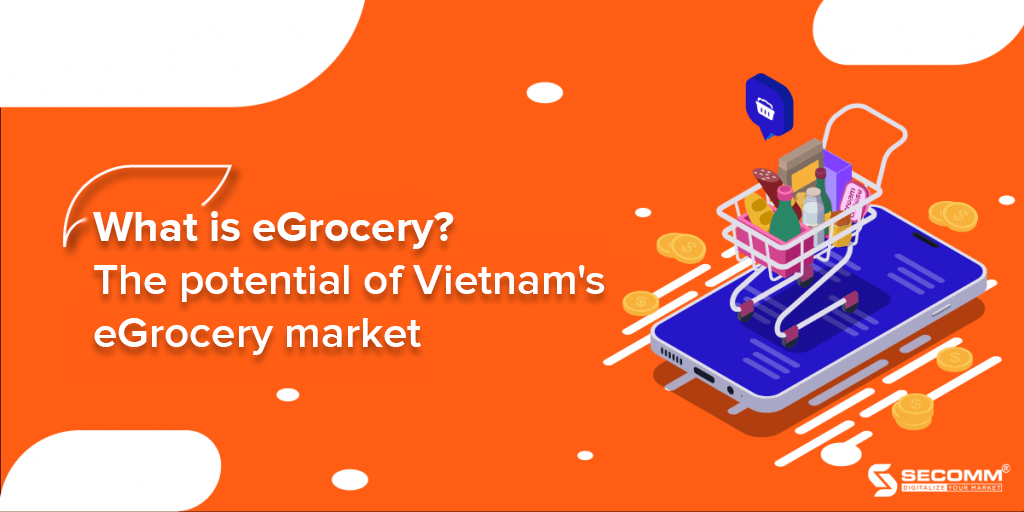
WHAT IS EGROCERY? THE POTENTIAL OF VIETNAM’S EGROCERY MARKET
According to the VISA’s data in 2021 – the world’s leading electronic payment technology company, up to 87% of Vietnamese consumers surveyed are currently using home delivery services, of which 82% said that the first time they used this service was since the Covid-19 outbreak occurred.
That further confirms that social distancing and work-from-home models have led to significant consumer shopping behavior changes. In particular, the transition from the direct shopping experience to e-commerce has taken place rapidly in just a few months. One of the industries that have benefited the most from the boom in the e-commerce market is eGrocery.

So, what is eGrocery?
eGrocery (or Grocery Ecommerce) includes online business activities of grocery products such as food (both fresh and prepackaged), household products, healthcare, personal care, etc. Product display, ordering to pay, and shipping are all done on the website of eGrocery businesses.
Some successful eGrocery businesses in the Vietnamese market are Bach Hoa Xanh, An Nam Gourmet, Organica, Farmer’s Market, etc.
The potential of Vietnam’s eGrocery market
Covid-19 is a powerful catalyst, one of the impulses to boost the grocery industry’s demand for shopping for essential products. According to a report from iPrice, websites specializing in the grocery business grew by 45% in traffic when people started staying at home to prevent the epidemic. After the social distancing eases, this trend remains stable, increasing by 10% by the end of 2021. eGrocery is the only industry that has maintained solid growth throughout the pandemic since the beginning of the pandemic, with search demand still increasing steadily.
Additionally, with revenue coming from the U.S, the worldwide eGrocery market is also highly active. The grocery e-commerce business is anticipated to surpass $20 billion in 2021 and $24 billion in 2023 (Statista). According to Redseer’s report, India’s eGrocery market is estimated to reach $10.5 billion by 2023.
Seeing the vast potential that the eGrocery market may bring, now there are many “big guys” not from the traditional grocery industry who also jump in to fight for this lucrative “piece of cake” like Con Cung, Kids Plaza, etc.
Case Study
BigBasket – The giant in the eGrocery market in India
BigBasket was founded in 2011 by V.S. Sudhakar, Hari Menon, V.S. Ramesh, Vipul Parekh, and Abhinay Choudhari. In May 2021, Tata Group’s acquisition of 64% of BigBasket shares helped push BigBasket’s valuation to $1.85 billion.
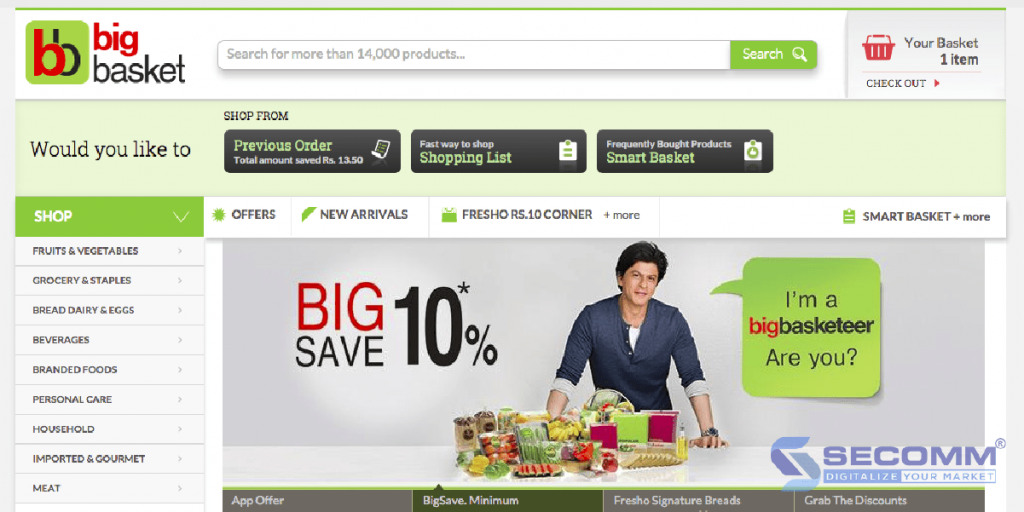
By promoting the research and development of transportation services and expanding the logistics function system in the enterprise’s e-commerce website, in 2016, BigBasket made fast deliveries within 60 minutes. In the same year, BigBasket also built a B2B delivery service to serve the food needs of restaurants and customers in major Indian cities. This business strategy has been a solid stepping stone for the BigBasket brand in the Indian online department since 2017
Blinkit (Formerly Grofers) – Fastest Delivery Business in India
Grofers is India’s 3rd largest grocery e-commerce platform, with about 13% of the market share, behind only BigBasket (37%) and Amazon (15%). Founded in 2013 by two technology engineers, Albinder Dhindsa and Saurabh Kumar, after the two founders noticed a massive gap in the local logistics services.
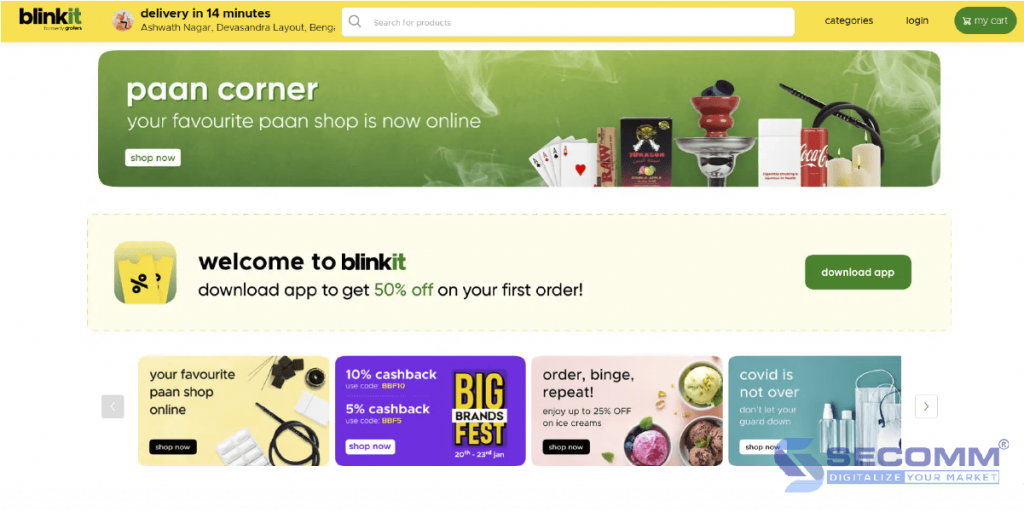
Initially, Grofers only specialized in supplying grocery products such as packaged food, bakery products, mother and baby care, pets, etc., to local grocery stores, medical, restaurants, or supermarkets. But thanks to the advancements in technology successfully applied in the e-commerce strategy, Blinkit has rapidly expanded its business successfully in 28 Indian cities.
On December 13, 2021, Grofers officially changed its brand name to Blinkit to deliver within 10 minutes. Like BigBasket, Blinkit also focuses on developing its logistics system and expanding its network of partner brands on its e-commerce website. Blinkit has more than 60 partners in New Delhi, more than 30 partners in Gurgaon, and many in Mumbai, Kolkata, Bengaluru, etc.
Bach Hoa Xanh – MWG’s strategic card in the eGrocery market
Bach Hoa Xanh is a mini supermarket chain selling fresh food and necessities under the Mobile World Joint Stock Company (MWG). Bach Hoa Xanh has nearly 2,000 stores across the South, East, and South Central provinces. According to iPrice, this website is in the top 5 most visited e-commerce websites in Vietnam, just behind four e-commerce platforms (Shopee, Lazada, Tiki, and Sendo).\
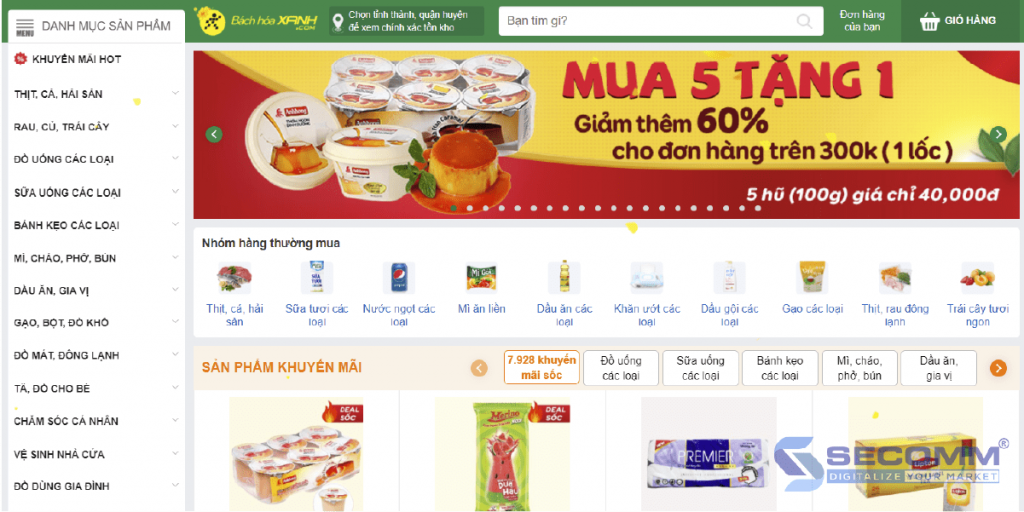
Since its establishment in 2015, Bach Hoa Xanh has advocated two key campaigns, competing with traditional markets and developing e-commerce websites. At first, Bach Hoa Xanh set up branches at selling points near the market, but in suburban areas and provinces, the space rental cost is much more affordable than in the central area. At the same time, the company creates a website system to boost online sales channels and draw in customers who enjoy making purchases online, particularly young people.
These days, the company has officially entered the Vietnamese retail “triad association” with Saigon Coop and WinMart (formerly VinMart), achieving a record of 26,300 billion VND in revenue in 2021 – an increase of 38% compared to the first 11 months of 2020.
Besides Bach Hoa Xanh, some other successful businesses have been applying grocery e-commerce, such as An Nam Market (specializing in serving foreign customers or former international students in Vietnam); Organica (focusing on offering customers from around the world ecologically friendly items), etc.
eGrocery is still in development and has not yet formally taken off. Thus the market’s growth potential is still tremendous despite the existence of several major companies. To confidently enter this lucrative market, grocery stores in Vietnam can use the lessons learned from their forebears and select a platform to construct a website system that fits the e-commerce business model.
Our company – SECOMM has been partnering with many big enterprises such as An Nam Group (Vietnam), Jasnor (Australia), and Changi Airport Group (Singapore). We are aware of the challenges and worries faced by firms while developing an e-commerce website system.
Get in touch with us now for FREE ecommerce consultancy and solutions in eGrocery businesses.
 2
2

 3,044
3,044

 0
0

 1
1
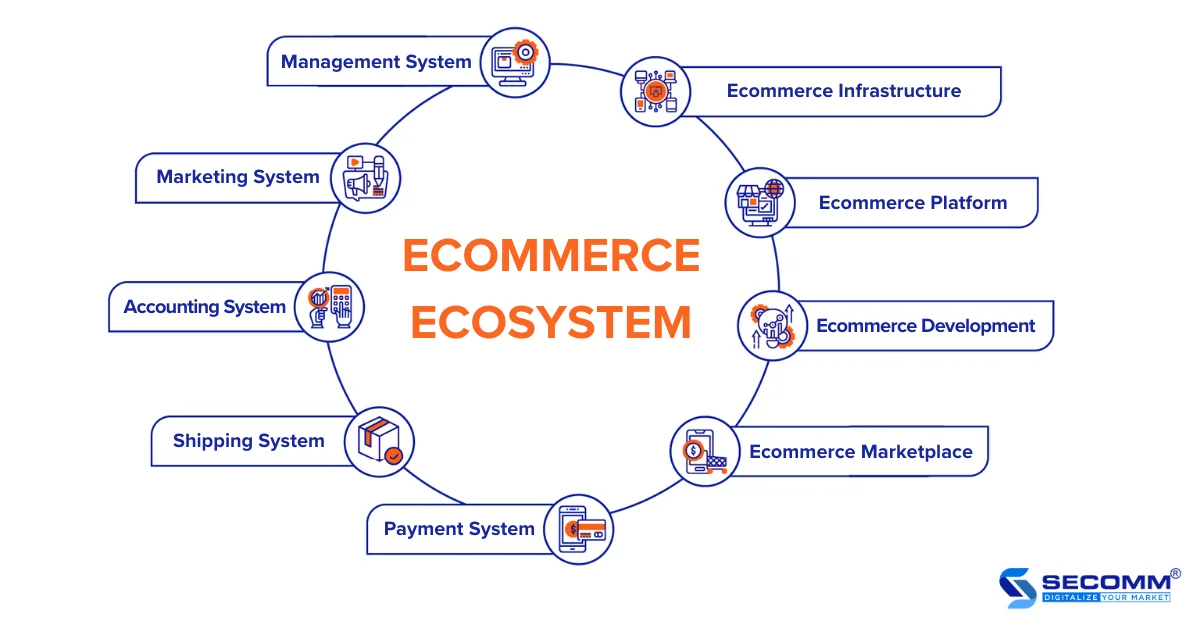
ECOMMERCE ECOSYSTEM: A CHALLENGE FOR VIETNAMESE BUSINESS
The ecommerce (Electronic Commerce) ecosystem is an open space that facilitates all interactions, connecting human factors, social elements, and information technology platforms with applications and services to provide value and efficiently operate components within the ecosystem. So, what are the components of the ecommerce ecosystem?
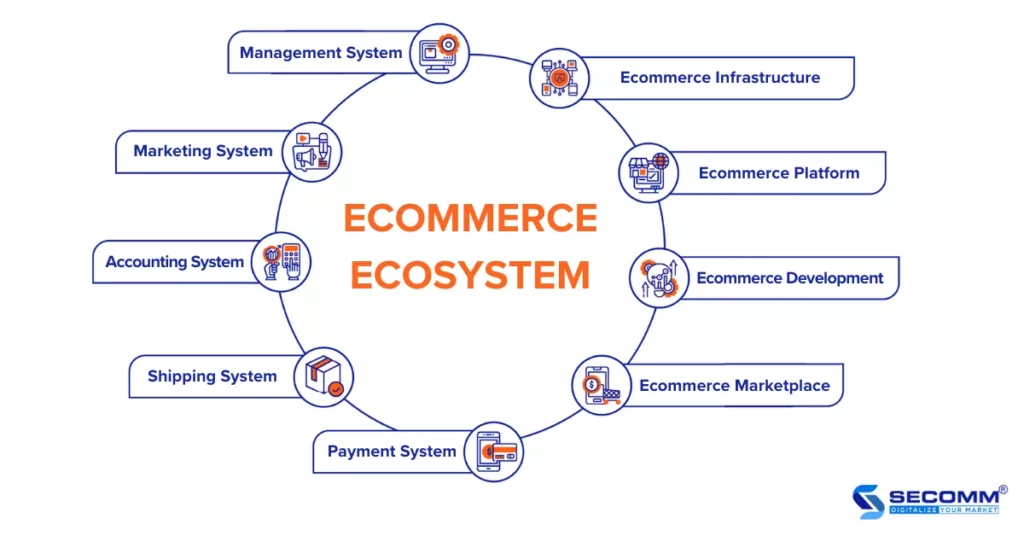
Ecommerce Ecosystem: Infrastructure
The system includes hardware (servers and devices), software (services/tools for management, and analysis), network systems, and physical facilities that form the foundation for the remaining components, ensuring smooth and efficient ecommerce processes.
Ecommerce Ecosystem: Ecommerce Platform
Software applications are used to build and manage all activities within the system. Currently, businesses often use platforms such as Magento, Shopify, BigCommerce, WooCommerce, Haravan, and Wix to create ecommerce websites.
Ecommerce Ecosystem: Ecommerce Development Services
Provides services and solutions for developing websites, systems, and ecommerce processes. Some popular ecommerce solution providers in Vietnam include SECOMM, SmartOSC, Isobar, etc.
Ecommerce Ecosystem: Ecommerce Marketplace
Provides an environment and all the services supporting ecommerce, allowing easy buying and selling between multiple sellers and buyers. Popular ecommerce marketplaces in Vietnam include Shopee, Lazada, Tiki, Sendo, etc.
Ecommerce Ecosystem: Payment System
Includes networks, systems, and devices processing all transactions within ecommerce. In addition to common payment methods such as cash, card payments (domestic cards, Visa, Mastercard, etc.), payment gateways (OnePay, PayPal, etc.), and e-wallets (Momo, ZaloPay, etc.) are developing in Vietnam.
Ecommerce Ecosystem: Shipping System
The shipping system includes all processes for managing, distributing goods from warehouses, packaging, and delivering to customers. Popular shipping service providers in Vietnam include Giao Hàng Tiết Kiệm, Giao Hàng Nhanh, ViettelPost, J&T, Ahamove, etc.
Ecommerce Ecosystem: Accounting System
Supports businesses in managing data related to invoices, sales revenue, and all financial flows in ecommerce activities. The emergence of e-invoicing software such as E-Invoice, MISA meInvoice, FPT.eInvoice, etc., has greatly supported accounting processes.
Ecommerce Ecosystem: Marketing System
Marketing activities support effective brand and product development, reaching and personalizing customer experiences through strategies, channels, and supporting tools.
Ecommerce Ecosystem: Management System
Uses resource management and operational process management software to enhance seamlessness and efficiency for the entire ecommerce system. Commonly used management systems include ERP, CRM, IMS, POS, OFM, etc.
In general, the components of the ecom ecosystem operate through a system of mechanisms, policies, and consistent laws to form a secure electronic data exchange system, ensuring the rights and responsibilities of businesses and consumers.
To achieve outstanding and sustainable growth, besides optimizing opportunities, businesses need to build a complete for themselves, creating a platform to enhance interactions between businesses, the market, and users more robustly. However, most Vietnamese businesses still face many challenges in building their ecommerce business plans. The majority of businesses have not correctly identified the necessary and appropriate components for their business models, leading to issues related to deployment time and budget constraints.
 2
2

 5,278
5,278

 0
0

 1
1
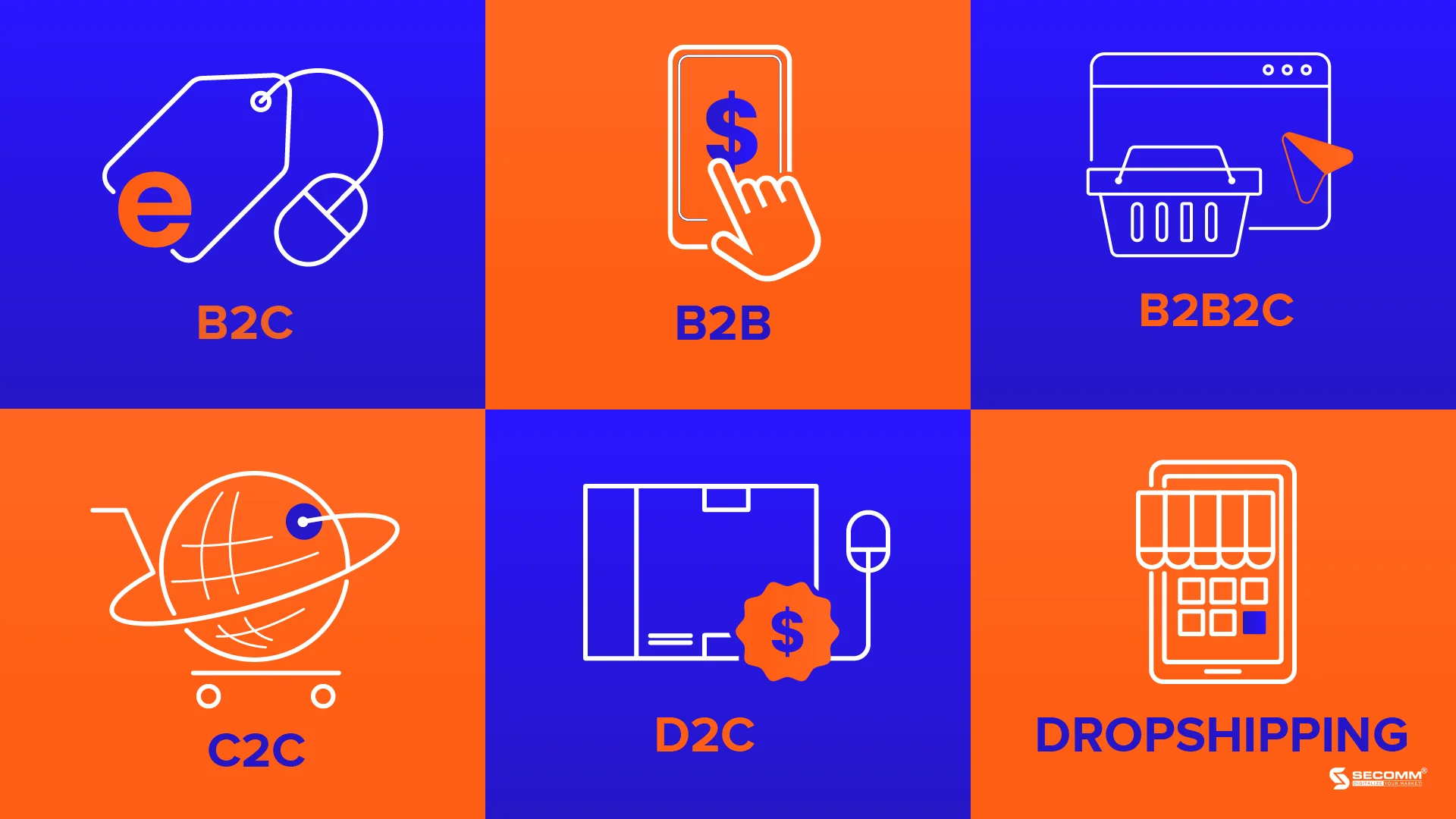
TOP 6 POPULAR ECOMMERCE BUSINESS MODELS IN VIETNAM 2021
Ecommerce Business Model: B2C
B2C (Business To Customer) involves transactions between businesses and customers. This is also the most popular model in the Vietnamese market.
The Gioi Di Dong is the number 1 retail model in Vietnam for electronic devices such as phones, laptops, tablets, and accessories.
- Website: https://www.thegioididong.com/
- Traffic: 49,447,704 (7/2021)
- Website ranking: #18 (Vietnam), #1,075 (Global)
Ecommerce Business Model: B2B
B2B (Business To Business) involves commerce between two businesses.
TELIO is the first B2B e-commerce platform in Vietnam, connecting small-scale traditional retailers with brands and wholesalers on a centralized platform. By aggregating needs, Telio can provide small retailers with more choices, better prices, and more efficient backend support through economies of scale.
- Website: https://www.telio.vn/
- Traffic: 16,109 (7/2021)
- Website ranking: #37,337 (Vietnam), #2,041,569 (Global)
Ecommerce Business Model: B2B2C
B2B2C (Business To Business To Customer) is a collaborative business model between two businesses (B2B) to create and deliver products, services to end consumers (B2C).
Shopee is the most popular e-commerce platform in Vietnam. Shopee Vietnam initially operated as a C2C model, acting as an intermediary in the buying and selling process between individuals. However, Shopee Vietnam has now evolved into a B2B2C model by providing many services and utilities to support the shopping process for both businesses and consumers.
- Website: https://shopee.vn/
- Traffic: 108,842,585 (7/2021)
- Website ranking: #4 (Vietnam), #325 (Global)
Ecommerce Business Model: C2C
C2C (Consumer To Consumer) is a form of business between two individuals, not businesses.
Chotot is a C2C e-commerce website supporting individuals in buying and selling real estate, cars, recruiting, used electronics, pets, and home services.
- Website: https://www.chotot.com/
- Traffic: 36,610,361 (7/2021)
- Website ranking: #50 (Vietnam), #3,369 (Global)
Ecommerce Business Model: D2C
D2C (Direct to Customer) is a form of providing products directly from businesses to customers, bypassing intermediary distribution steps.
Lavender specializes in directly supplying premium bed sheets for homes and hotels in the e-commerce market without relying on any distributors.
- Website: http://lavendervn.com/
- Traffic: 14,036 (7/2021)
- Website ranking: #96,325 (Vietnam), #4,886,255 (Global)
Ecommerce Business Model: DROPSHIPPING
Dropshipping is a business model that allows online stores to operate without storing inventory, owning products, and shipping products to customers.
Selly is an e-commerce platform that supports business sellers without the need for capital, or inventory storage and takes care of shipping to consumers.
- Website: https://www.selly.vn/
- Traffic: 24,936 (7/2021)
- Website ranking: #58,359 (Vietnam), #2,747,670 (Global)
To inquire about free consultation on ecommerce solutions, please contact SECOMM for expert advice.
 2
2

 9,567
9,567

 0
0

 1
1
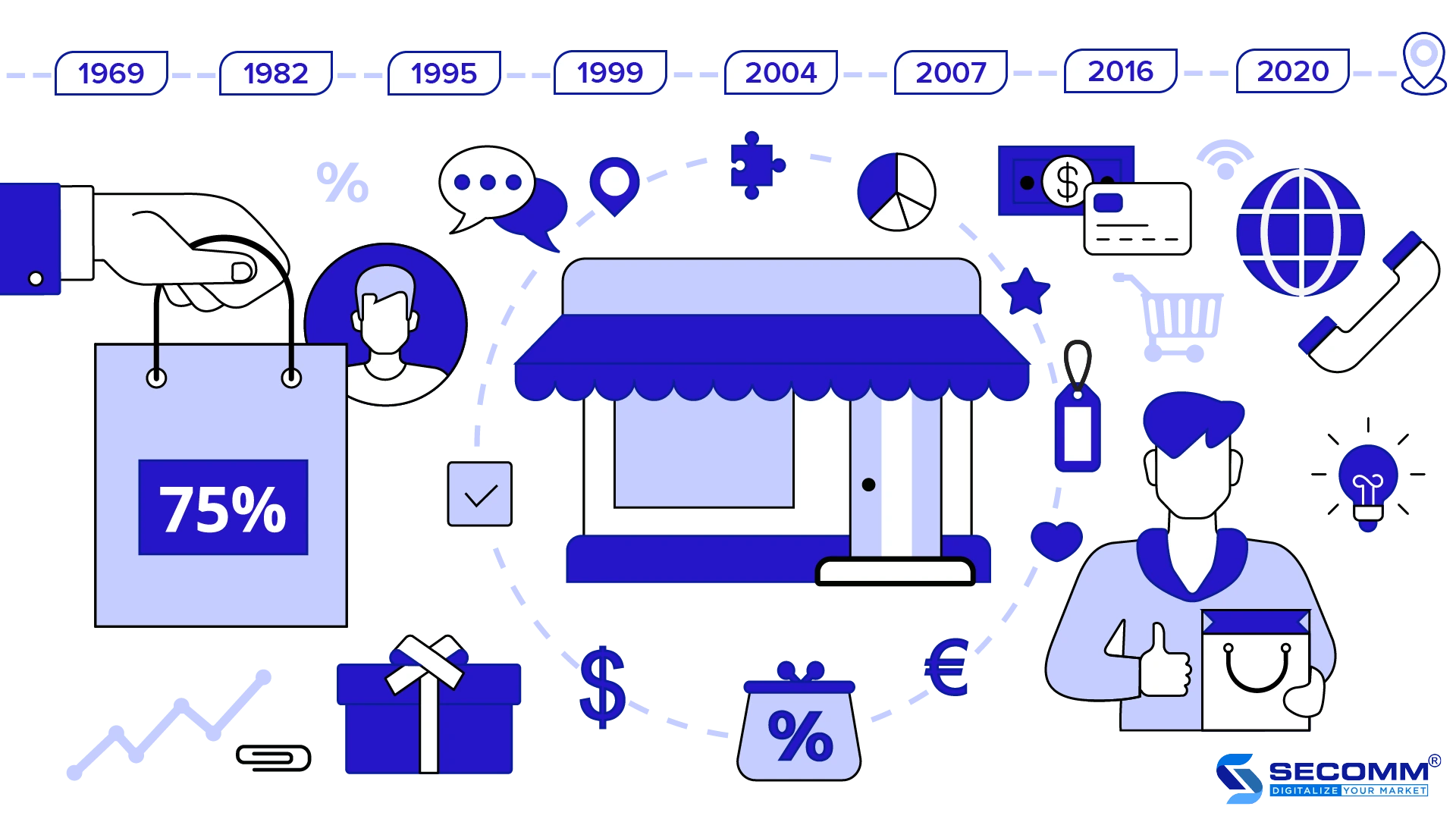
OVER 50 YEARS OF GLOBAL ECOMMERCE JOURNEY (1969 – 2020)
OVER 50 YEARS OF GLOBAL E-COMMERCE JOURNEY (1969 – 2020)
1969: The first online service provider – CompuServe
In 1969, Dr. John R. Goltz, Jeffrey Wilkins, and electrical engineering students founded CompuServe – a service that provided an information-sharing portal through the Internet and email network connections.
1979: Father of electronic commerce (EC) system – Michael Aldrich
Michael Aldrich pioneered the first EC system by connecting a television and a computer for transaction processing via telephone lines, enabling a secure information system to be opened and shared externally. This innovation laid the foundation for the development of modern EC systems.
1982: The first ecommerce company – Boston Computer Exchange
Initially a store supporting the resale of used computers, Boston Computer Exchange became one of the earliest models for today’s EC companies.
1992: The first online book market – Book Stacks Unlimited
Charles M. Stack established the brand Book Stacks Unlimited as the world’s first online book store. Initially using a dial-up bulletin board format, the company later transitioned to the Internet to create an online book trading market.
1995: Birth of the ecommerce giant – Amazon
Jeff Bezos founded Amazon initially as a book-selling business but later expanded its business model to include various products by incorporating new technologies such as cloud computing and artificial intelligence. Amazon ushered in a new era for the EC industry by integrating Internet technology into its business strategy.
1998: Online payment gateway, a platform for ecommerce development – PayPal
Confinity (the predecessor of PayPal) was founded by Max Levchin, Peter Thiel, Luke Nosek, and Ken Howery. In 2000, eBay acquired Confinity and renamed it PayPal, the world’s largest online payment gateway. PayPal addressed many limitations of traditional payment methods, making the buying and payment process more convenient and laying the foundation for EC development.
1999: The king of the ecommerce industry in China – Alibaba
Alibaba officially entered the EC market, successfully raising $25 million in capital. By 2001, the company became profitable and led the EC platform under the B2B, C2C, and B2C business models. In 2020, Alibaba contributed $12.2 billion to global EC revenue.
2000: Online advertising tool serving ecommerce marketing – Google AdWords
Google introduced Google AdWords, the world’s first online advertising tool. This tool supported businesses in marketing their products on Google’s search network, boosting sales for EC companies at that time.
2004: The first ecommerce website development platform – Shopify
After unsuccessful attempts to build an e-commerce website selling snowboarding equipment on various platforms, Tobias Lütke and Scott Lake founded Shopify – the first platform supporting the development of EC websites worldwide. This platform enables users to easily create online stores without requiring extensive technical knowledge.
2005: Ecommerce event – Cyber Monday
The National Retail Federation (USA) coined the term “Cyber Monday” to describe the first Monday after Black Friday, initiating the online shopping season between Thanksgiving and Christmas. This event marked economists’ interest in the global retail market.
2007: Sustainable ecommerce development platform – Magento
Developed by Roy Rubin and Yoav Kutner in 2007, Magento is an open-source platform written based on the Zend Framework and PHP programming language, specifically designed to build complex EC websites. Magento, known for its multitasking capability, high performance, flexible customization, and easy scalability, has become the top choice for enterprises with 200,000 partners and 2.5 million downloads worldwide.
Multinational corporations using Magento to build sophisticated EC systems include Samsung, Nike, Coca-Cola, Asus, HP, Lenovo, Canon, Sigma, Olympus, Port, Pox, Nestle, BevMo, Burger King, and millions of small and medium-sized EC sites globally.
2016: Facebook joins the ecommerce
game – Facebook Marketplace
With the ambition to dominate the EC market, Facebook, a tech giant, continuously introduced new features on Facebook Marketplace, Instagram, and WhatsApp, and collaborated with various EC platforms (Shopify, OpenCart, BigCommerce, WooCommerce, and Magento). This made giants like Amazon, Lazada, and Shopee wary, demonstrating the strong allure of the EC market.
2017: Growth of ecommerce
The global EC industry set a new revenue record of $2.352 trillion in 2017, a 25% increase from 2016 (according to eMarketer – a US market research company). Cyber Monday alone surpassed $6.5 billion in online sales. Economists predict that EC will be the world’s focal industry by 2025.
2020: COVID-19 boosts the ecommerce explosion
2020 marked a significant turning point for the global EC industry. The impact of COVID-19 accelerated the construction of EC systems to meet consumer demands promptly. Currently, EC is not only present on platforms like Amazon, Shopee, and Lazada but also brands are starting to build their own EC websites. Additionally, EC spans various sectors from fast-moving consumer goods (fashion, food, technology) to service sectors (travel, finance, education, furniture, and real estate).
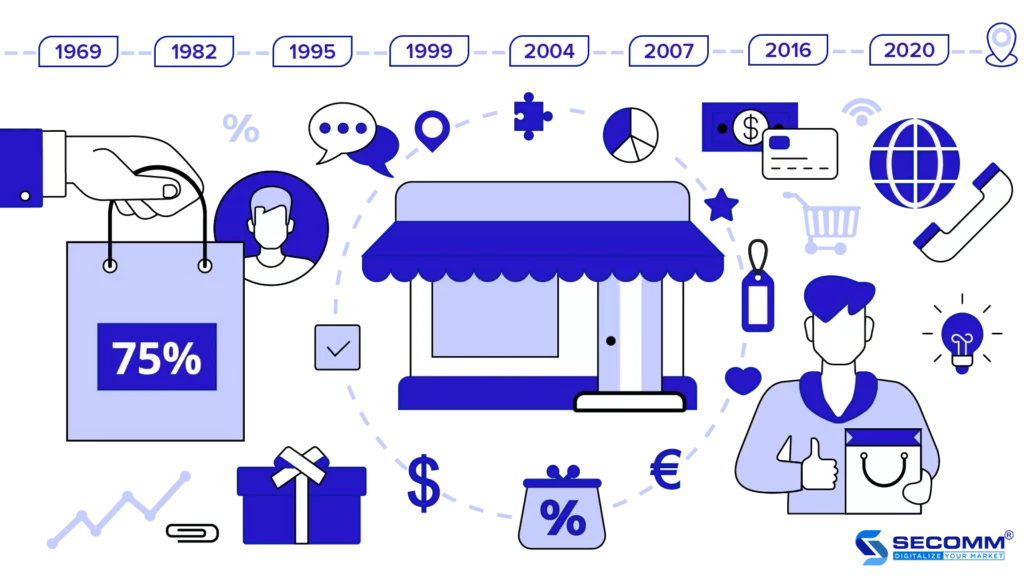
According to the “Southeast Asia Internet Economy 2020” report by Google & Temasek, consumers tend to spend more time shopping online than before COVID-19 (increased from 3.7 hours/day to 4.7 hours/day). Global B2C EC revenue increased from $1.948 trillion to $4.280 trillion, doubling Statista.com’s forecast of $2.238 trillion.
COVID-19 has brought positive effects on the global rise of the EC industry and opened up new opportunities for the Vietnamese economy.
 2
2

 4,530
4,530

 0
0

 1
1
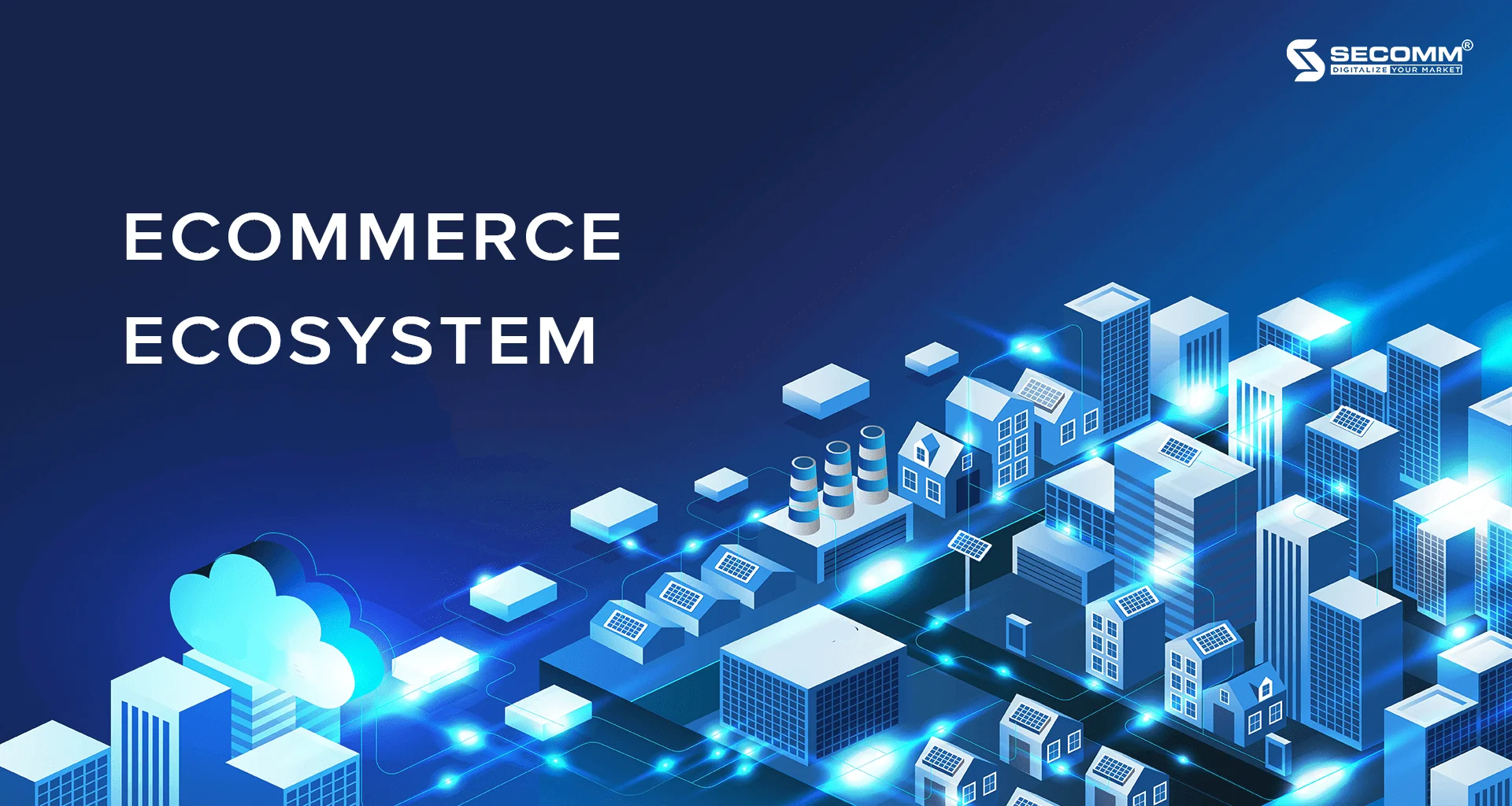
ECOMMERCE ECOSYSTEM GRASPING FOR EFFICIENTLY BUSINESS-DRIVEN
Vietnamese ecommerce businesses are welcoming transformational opportunities amidst the rapid development of technology, market, consumer, and major investor presence. However, for outstanding and sustainable growth, in addition to seizing opportunities, businesses need to build a comprehensive ecommerce ecosystem. Therefore, a best-finish of the ecosystem in general and its components, in particular, is the foundation stimulating businesses, markets, and user interactions.
So, what are the components of the ecosystem? How should the business develop the ecosystem in line with its business strategy?
What components are included in the ecommerce ecosystem?
The ecommerce ecosystem is an interconnected community implementing all interactions and connections of human organisms, social organisms, information technology and applications, and services to provide value and effectively operate the components in the ecosystem. (Based on the concept of Assoc. Prof. Dr. Nguyen Van Hong)
The ecosystem components are operated through consistent mechanisms, policies, and laws to create a secure data interchange system, ensuring the rights and duties of businesses and consumers.
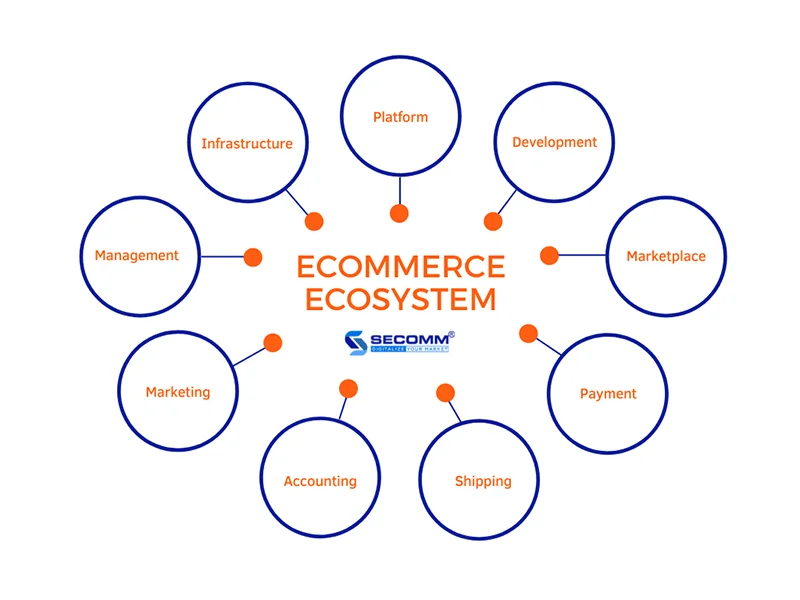
The main components:
- Ecommerce infrastructure system includes hardware (servers and devices), software (services/tools for managing and analyzing), networks, and facilities forming the basis for the remaining components and ensuring that all e-commerce processes run smoothly and efficiently.
- Ecommerce platform is a software application to build and manage all the activities. Today’s well-known ecommerce platforms can be mentioned as Magento, Shopify, BigCommerce, WooCommerce, Haravan, Wix,…,
- The development component provides services and solutions for ecommerce websites, systems, and processes. In Vietnam, some of the notable ecommerce service and solution providers may include SmartOSC, Isobar, SECOMM,…
- Marketplace provides an environment and all services to support ecommerce, allowing commercial activities between plenty of sellers and buyers. The leading ecommerce marketplaces in Vietnam can point to Shopee, Lazada, Tiki, Sendo,…
- The payment includes networks, systems, and devices processing all ecommerce transactions. Currently, jointly with the payment, card types (domestic card, Visa, Mastercard,…), payment gateways (OnePay, PayPal, …) or e-wallets ( Momo, ZaloPay, ..) have been developing in Vietnam.
- The shipping system includes the entire process of managing and distributing goods from the warehouse, packaging and delivering to customers. Typically shipping providers are Giao Hang Tiet Kiem, Giao Hang Nhanh, ViettelPost, J&T, Ahamove,…
- Accounting software helps manage all data on ecommerce invoices, sales revenue, and cash flows. The birth of e-invoice software such as e-invoice, MISA meInvoice, FPT.eInvoice,… has maximally supported accounting processes.
- Marketing supports promoting brands and products, and simultaneously approaches and personalizes customer experience through strategies, channels, and tools.
- Management system uses the resource and operational processes software to enhance the seamlessness and performance of the entire ecommerce system. The most popular management systems are ERP, CRM, IMS, POS, OFM, etc.
How has the ecommerce ecosystem developed and perfected?
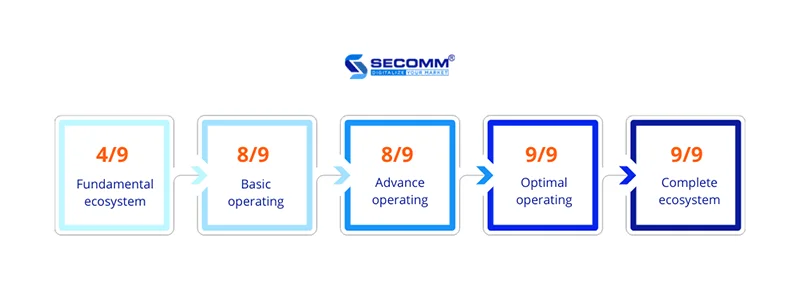
Stage 1: The fundamental ecommerce ecosystem
In the 1st stage, while customers are not been aware of their purchasing needs, the ecommerce ecosystem has fundamentally formed, beginning to approach, educate and stimulate consumers’ concern about brands and products.
Basic components (4/9): Infrastructure, Platform, Marketplace, Marketing
- Infrastructure: essentially participating in the ecosystem, mainly using desktop and network devices, data systems, and facilities to support operating other components inside the ecosystem.
- Platform: building website on simple platforms, including simple ecommerce interface and functions.
- Marketplace: implementing sales on the ecommerce marketplaces to run sales-efficiency experiments, increase brand popularity, and approach a wide range of users for nurturing potential customers.
- Marketing: using social media, advertising, content, email,… to increase views, and traffic and build awareness of brands, products, and services in the potential customer mindset.
Highlight components: Marketplace, Marketing
Inchoate components: Development, Payment, Shipping, Accounting and Management
Stage 2: The basic-operating ecommerce ecosystem
Customers become aware of their needs at this stage. As a result, the ecosystem comes into operation to approach potential customer needs.
Basic components (8/9): Infrastructure, Marketplace, Platform, Development, Marketing, Payment, Shipping, Accounting
- Infrastructure: well-developed, ensuring all the seamless processes and interactions among components.
- Marketplace: maintaining sales operation with constantly renewed programs and events to attract potential customers.
- Platform: operating the end-to-end system, continuously updating new versions to enhance the increasing performance.
- Development: developing and operating the ecommerce system and continuously improving system productivity.
- Payment: perfecting the payment processing system and fully integrating payment gateways.
- Shipping: perfecting the shipping system and partnering with shipping providers to deliver the first orders.
- Accounting: completing the accounting and financial system to manage all ecommerce transactions
- Marketing:
- Increasing web-display frequency on search engines to increase brand and product identification and attract more potential targets.
- Continue promoting social channels, advertising, content, email,… to improve the experience, education, and conversions for target customers.
Highlight components: Marketing, Payment, Shipping, Accounting
Inchoate components: Management
Stage 3: The advance-operating ecommerce ecosystem
The ecosystem enhances operation with many essential functions to directly navigate customers’ searching and buying considerations, thereby increasing the customer funnel conversion.
Advanced components (8/9): Infrastructure, Development, Marketplace, Platform, Payment, Shipping, Accounting, Marketing
Maintaining components: Infrastructure, Development, Marketplace, Accounting
Highlight components: Platform, Payment, Shipping, Marketing
- Platform: investing in developing the ecommerce system with a dedicated platform to operate and process complicated functions optimally.
- Developing new functions to optimize user experience: interface renewal, promotion features (pop-up, banner,…), customer service (live-chat, chatbot),…
- Optimizing the “Call-to-action” function and gathering emails on the website, at the same time implementing sale-off, and promotion programs to increase conversion
- Payment: integrating more payment methods to diversify the checkout experience, from COD payment, and internet banking to VISA, Mastercard, or e-wallets.
- Shipping: optimizing the packaging process, improving delivery speed by partnering with transportation providers or building an in-house delivery team, in addition, optimizing operational processes for instant order fulfillment.
- Marketing:
- Website: concentrating on blog content and optimizing product detail content.
- Continuously maintaining Social Marketing performance
- Focusing on the email channel to nurture and stimulate potential customers.
Inchoate components: Management
Stage 4: The optimal-operating ecommerce ecosystem
When customers transition to the decision-making stage of purchasing, the ecosystem maximizes effectiveness in all processes and operational components, simultaneously focusing on developing conversion functions through continuous improvement and innovation of marketing components.
Optimal components (9/9): Infrastructure, Development, Marketplace, Platform, Payment, Shipping, Accounting, Marketing, Management
Maintaining components: Infrastructure, Development, Marketplace, Platform, Payment, Shipping, Accounting
Highlight components: Marketing, Management
- Marketing: focus on ecommerce marketing strategy
- Implementing email plans to remind abandoned carts to stimulate potential customers constantly
- Maintaining customer service using email channels to gather customer feedback and reviews while using products
- Promoting loyalty programs with discounts, accruing points, membership cards,… to increase return customers
- Management:
- Integrating ERP software to manage data, human resources, and processes more seamlessly
- Synchronizing Website with ERP and CRM to optimize operational processes and increase customer funnel conversion
Stage 5: The complete ecommerce ecosystem
All the ecosystem components are complete and effectively interact with each other. In addition, the ecosystem is directed towards operating maintenance to support product experience, customer retention, and return-customer stimulation.
Optimal components (9/9): Infrastructure, Development, Marketplace, Platform, Payment, Shipping, Accounting, Marketing, Management
Maintaining components: Infrastructure, Marketplace, Payment, Shipping, Accounting, Marketing
Highlight components: Platform, Development, Management
- Platform: using customer reviews to improve the quality of products, services, and system functions
- Development: providing solutions and developing specialized functions for a much more complex ecommerce system
- Management: seamlessly operating and managing all data, processes, and resources among website, ERP, CRM, and POS systems
Barriers Facing the ecommerce ecosystem in Vietnam
Although the ecommerce ecosystem in Vietnam is proliferating, it is being hampered by substantial barriers.
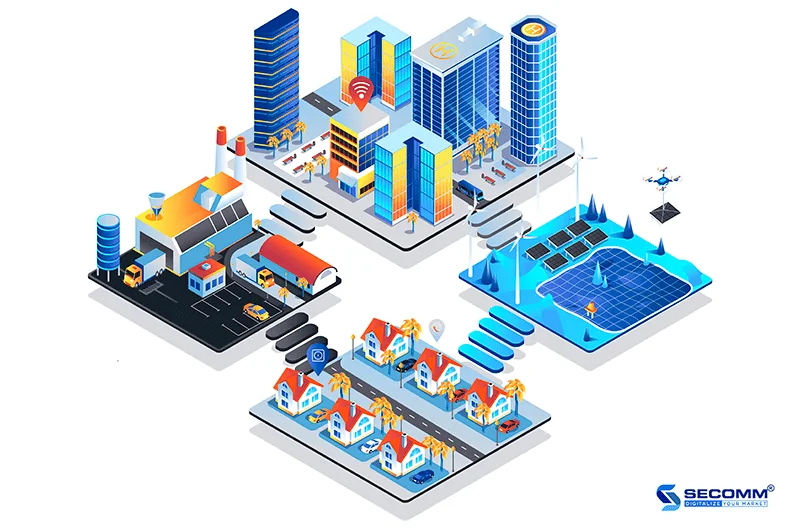
Outside barriers
Legal issues in ecommerce
In comparison to the general Vietnam market, ecommerce would be a relatively new business. As a result, the legal framework for ecommerce remains inadequate and disorganised. In which tax, security, and information authentication in e-transactions, intellectual property rights, etc., have not been adequately safeguarded by legal means.
The disparity between the legal framework’s perfection and the faster market change makes ecommerce challenging to control or at threat of unhealthy growth.
Circular No.47/2014/TT-BCT on the management of ecommerce websites, particularly, contains guidelines on the ecommerce business registration process and procedures. However, their controlling method has not been carried out properly, resulting in fewer registered businesses than actual statistics.
Therefore, most of the legalities of starting ecommerce business have not been verified, leading to transaction fraud and other fraud. More serious are domain misappropriation and spoofing by hackers to business counterfeiting, causing severe damage to businesses and consumers.
This shows that the current legal framework needs to enforce more specific steps to prevent attacks from cybercrime.
Consumer confidence
One of the significant barriers is the reality that occurs throughout the purchase process. For example, product and service quality issues, typically the quality assurance process (for counterfeits, poor quality products), transaction frauds (credit account takeover), and shipping (fraudulent goods exchange in packaging and shipping),… all have a direct impact on customer interests and the healthy, sustainable growth of the ecommerce ecosystem.
Investment barriers
Another significant barrier is the competition and investment budgets among businesses. In particular, data security requirements and infrastructure investments are putting financial pressure on existing ecommerce businesses. As a result, the ecommerce ecosystem is primarily controlled by the expansion of marketplaces and international businesses investing in the Vietnam market.
Inside barriers
Although the current number of ecommerce ecosystem components is fully completed, the uneven development level makes interactions and operational processes sporadic and challenging to achieve optimal growth. The challenges have mainly come from:
- Ecommerce infrastructure: The limitations of infrastructure, facilities, and capacity to access technology in rural areas create notable gaps compared to urban areas, affecting market coverage in Vietnam.
- Logistics: Logistics infrastructure has fallen behind ecommerce growth. The inequitable synchronization between logistics services and the lack of technology are still significant barriers for almost all SME logistics businesses in Vietnam.
- Payment: Cash payment (COD) accounts for a high percentage, 60%, of transactions in the entire e-payment market share. This creates more risk when parcel refusal and failed deliveries make the order fulfilment process more costly and time-consuming.
Besides, the most significant barrier is the lack of a strong connection among ecosystem components to bring unifying and synchronous ecommerce solutions. The current connections are commonly between marketplaces and shipping providers or digital banking/e-wallets to provide economical and intriguing solutions for consumers.
However, that seamless and unified connectivity has not yet evolved to maximize business interactions in the ecosystem and among businesses in the ecommerce market.
Solutions for SMEs
The ecommerce ecosystem completion is a sustainable foundation for SMEs to build and implement ecommerce business plans aligned with each business stage while generating a complete ecosystem for themselves.
About the number of components
Businesses should determine the suitable components according to each business model and growth stage.
For example, a small and medium-sized enterprise would use the essential ecommerce components, such as the platform, to develop a complete ecommerce system, complete payment, shipping, and integration processes integrating more management software, namely CRM, POS, accounting, and marketing tools.
Nevertheless, a medium/large-sized enterprise can integrate ERP for resource operation or omnichannel for efficient expansion.
About timeline
Following the identified ecosystem components, a business can estimate the appropriate timeline to promote in-time business processes, fully satisfying the market requirements and customer needs. Thereby, the satisfaction enhances the planning efficiency and the ecommerce ecosystem.
About the implementing budget
The budget would be distributed more specifically once the essential ecosystem components are clearly defined for your business model. Determining the proper budget is a critical factor for SMEs to successfully implement ecommerce and sustainably grow. This is especially important for existing SMEs due to the considerable budget pressures and the long-term investment process.
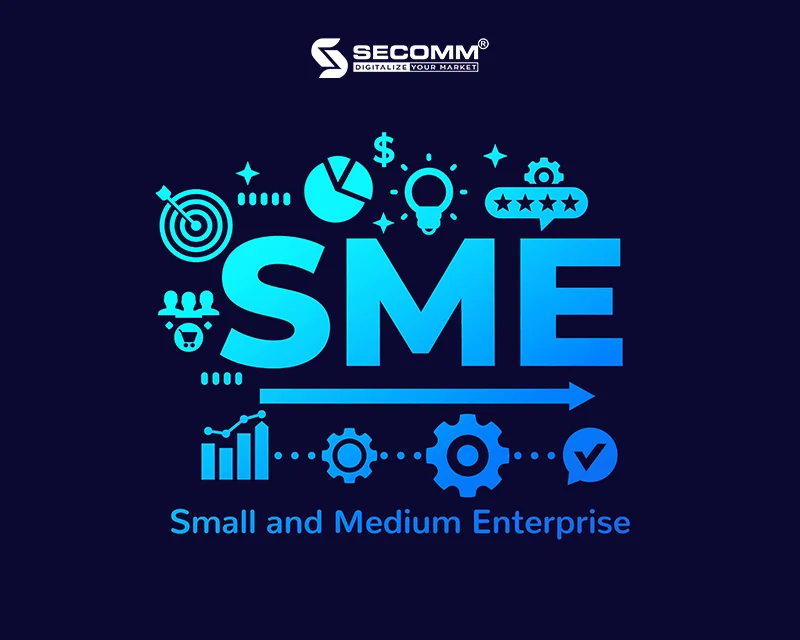
However, most of those SMEs still face many challenges in building their ecommerce plans. They have not adequately defined their business model’s needed and best-suited components, resulting in timeline and budget dilemmas.
With in-depth experience providing full-service ecommerce solutions, SECOMM will accompany businesses in respective stages of ecommerce implementation with tailor-made solutions.
Contact SECOMM to receive a comprehensive ecommerce consulting solution for your businesses.
 2
2

 4,826
4,826

 0
0

 1
1
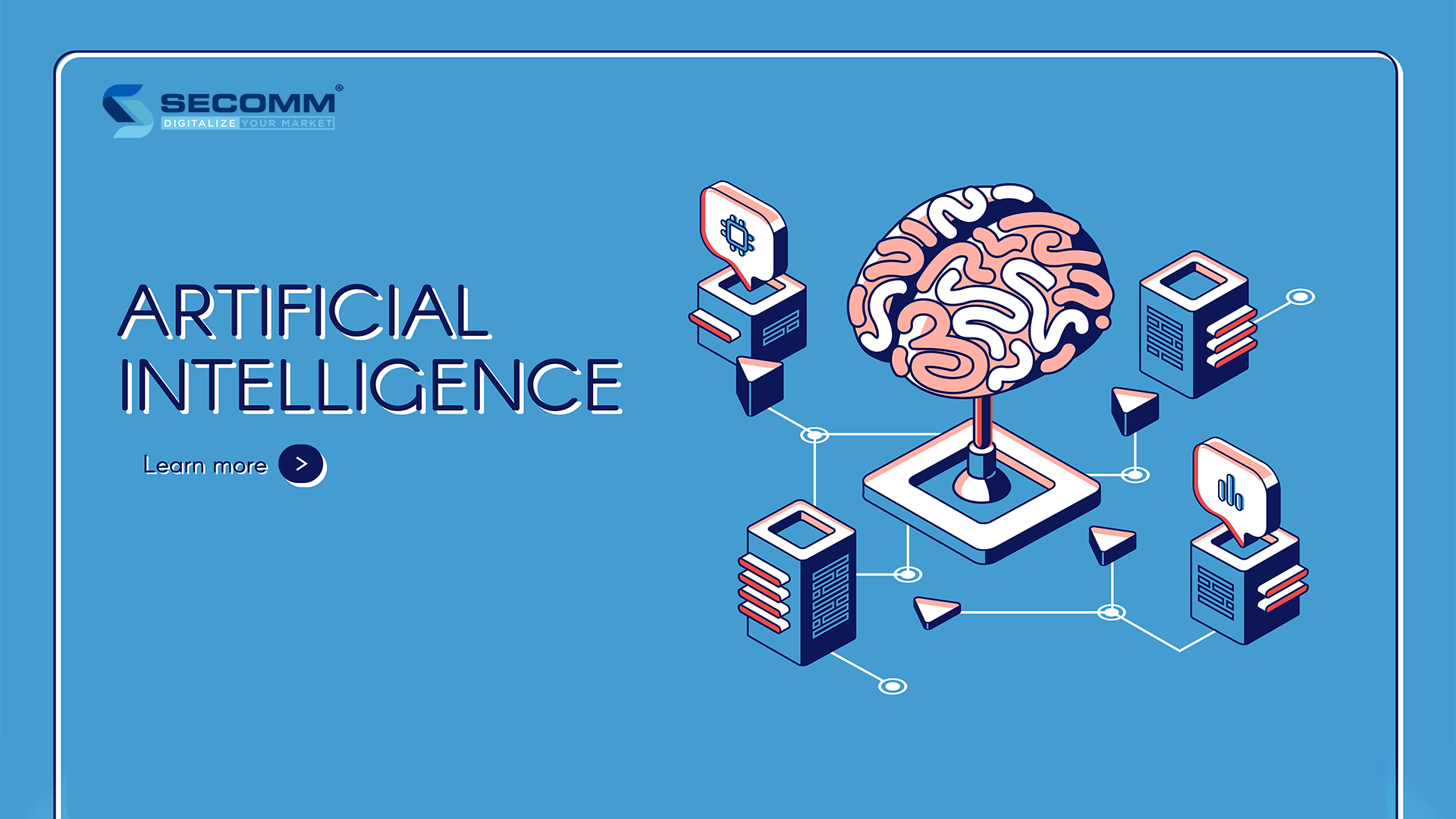
HOW AI TRANSFORMS THE ECOMMERCE EXPERIENCE?
1. How customers experience products in traditional shopping
Traditional shopping refers to the way customers directly buy products at stores, markets, or supermarkets. Since that trading model has emerged, the ecommerce experience about products has often originated from direct product-observation and -interaction. A consumer can hold and touch the item directly, feeling its characteristics, such as hardness, softness, size, or even color. They can quickly try one dress and exchange another one for a suitable size. This model has several benefits for shoppers:
- Guarantee of product quality: Customers have the opportunity to interact and observe the product directly before buying. At that time, customers can choose a product with complete packaging, favorite colors, or delicious fresh food, or a skirt of a suitable length.
- Time-saving in return and exchange policy: The traditional purchase is rooted in the amicable sale principle. Of course, the buyers will be partly responsible for goods quality due to the opportunity to touch and inspect them before buying.
- High-satisfaction level: Customers tend to be more enthusiastic and get more exciting feelings when using products. They will not put too much doubt on the reliability of the product.
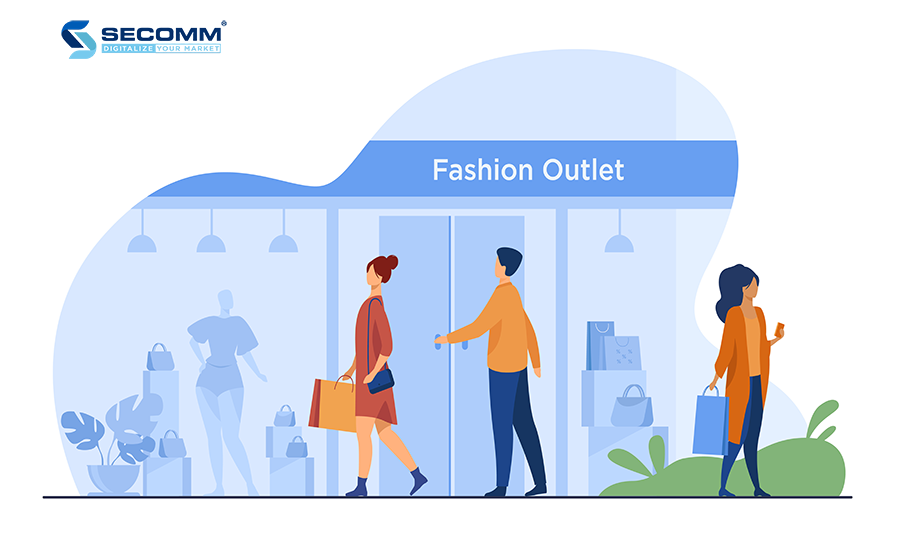
The benefits of experiencing products with traditional models will have many changes in online shopping models. Although customers will enjoy the convenience of freely choosing a suitable item in a wide range of goods at more bargained prices and also experience regular promotions, the limited interaction with the product pre-buying has reduced the convenience as the traditional model did before.
2. AI invention penetrating process to optimize the ecommerce experience
With the rapid development of the digital age, customer demand is a critical factor that is a priority in every development strategy and orientation. In particular, businesses also invest more in modern technologies to optimize consumer-product interaction, and AI applications are a useful option for ecommerce experience optimization process.

Within the Ecommerce field, AI aims to the product experience, contributing to the efficiency of the business’s customer-centric orientation. The AI application has been integrated into search engine systems to support the creative and effective searching process with features such as “search by image” associating with material, shape, size, or brand. The display technology also invests in improving product interaction, shortening the distance between online and offline models.
Moreover, AI supports the ecommerce industry as a knowledgeable online assistant. This technology can bring two-way benefits when supporting both user experience and data analysis about user behavior trends.
Those are the two factors motivating brands to invest in developing more modern and efficient AI platforms towards a smarter, automated model for perfect customer experience.
3. AI trends for smarter ecommerce experiences in the digital age
Since applying to the ecommerce industry, various AI technology types have contributed to significantly changing consumer habits and purchasing decision-making processes, ultimately optimizing the convenience that customers received from online shopping. However, AI tools are continually developing and improving every day to enhance the user experience, and they also regularly stay updated with many popular trends.
Product 3D view
The 3D formats have been practical to enhance more excited customer-product interactions. Customers can observe different product aspects or even try placing a small decoration item at any house location to check the product’s suitability. This invisibility generally creates exciting experiences to increase interaction making customers more interested in the product.

Some interior brands have been using 3D scanning technology to perfectly experience interior space and architecture. Based on a provided video, customers can enjoy AR via remotely 3D virtual reality technology.
Mobile virtual reality fitting room
That AI ability can be a perfect solution when a store has too many customers visiting at the same time while the fitting room is overloaded. Customers can scan product images and try them out on a mobile phone screen. This technology is already available on Lacoste’s app, supporting customers to try their favorite shoes freely via their smartphone.

The development of 3D and virtual reality technology has proved that nothing is impossible in the digital age. AI development is also a considerable solution for ecommerce barriers, mainly interacting with products when buying online to optimize ecommerce experience.
In the future, as many expert predictions, AI can be a modern and popular trend to optimize the ecommerce experience correctly. However, businesses also need to consider the needs of target customers to have appropriate applications and increase the number of potential customers and loyal customers in the long run.
 2
2

 2,689
2,689

 1
1

 1
1
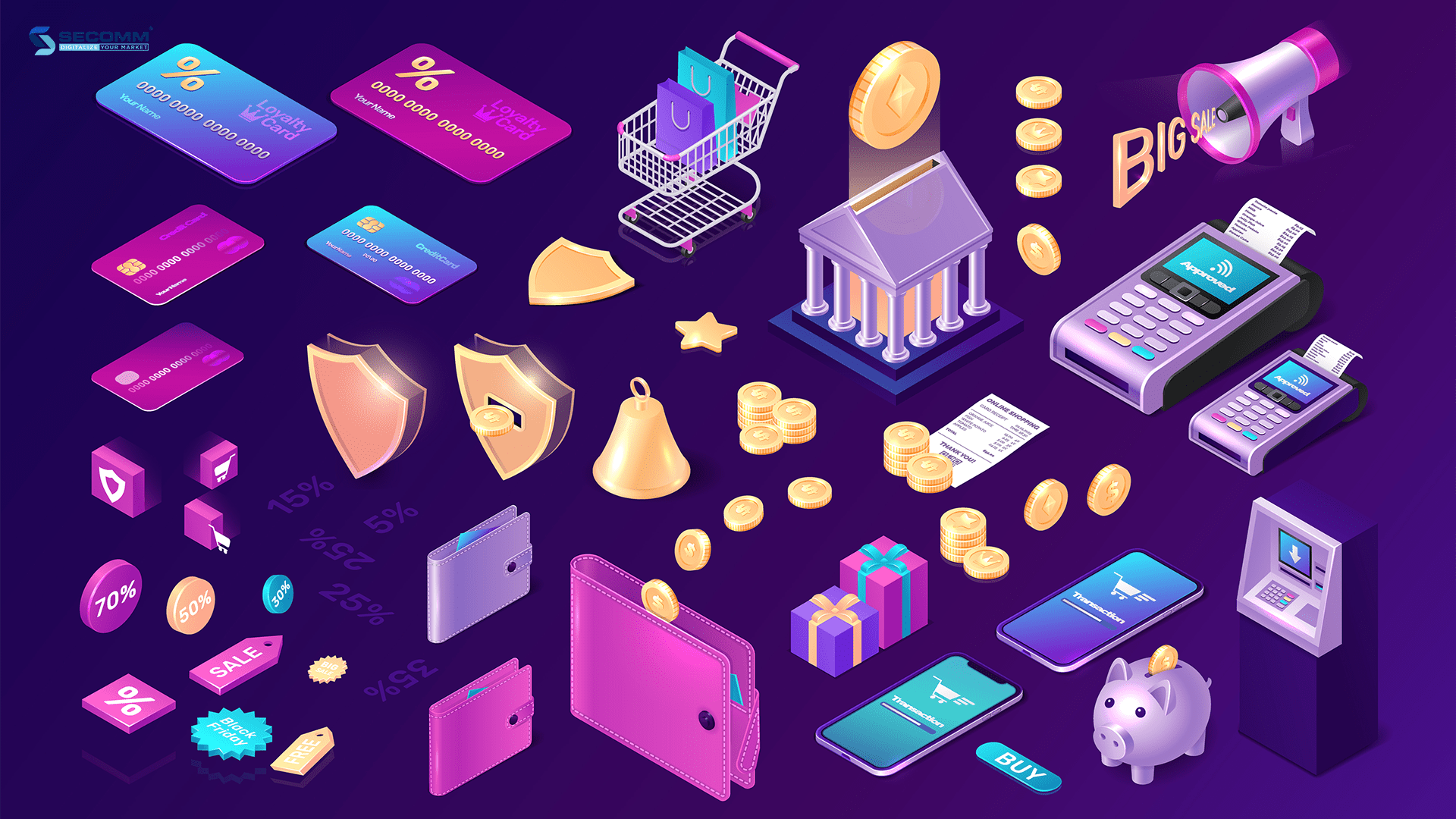
BREAKTHROUGH ECOMMERCE BARRIERS
1. Breakthrough ecommerce barriers with customer-centric orientation
Customer-centric orientation can significantly improve the problems that consumers are suffering from shopping online. This orientation is correctly a long-term process to breakthrough ecommerce barriers, follows the business for a lifetime, creates brand values as a result, and other measurable values, such as highly-appreciated customer feedback, increasing the number of products sold.
At first glance, customer-centric orientation looks quite general and tends to imply intangible values. However, the “customer-in-center” mindset can generate both cognitive and measurable values. Before it can create measurable values, the business needs to have a clear awareness and specific purpose of this orientation, maintaining it as a unified business culture.

To get started, be customer-friendly in all aspects—organizations at first need to analyze the customer community’s needs and insights. Customer feedback, including limitations from existing products/services on the market, service quality, promotion campaigns, is the foremost factor to consider. Proactively getting customer feedback on products and services is all valuable information; thus, organizations will have time to complete both product systems and customer service.
It is an equally critical factor that improving user interface can produce oriented rather than product-centric. Many businesses assumed that the “good wine needs no bush” developing style would naturally create attraction itself. Indeed, this style is not wrong; however, it is still not powerful enough in the long run. Proactively taking care of customers, receiving the limitations of existing products are the fastest steps to improve producing more appropriate products. Products tailored to the needs make customers perfectly comfortable in the user experience.
2. Set sales goal to prevent cash-flow issues and breakthrough ecommerce barriers
To breakthrough ecommerce barriers effectively, one of the critical things is to set clear business goals. It is difficult to predict future fluctuations; however, proactively create realistic goals and prepare everything to achieve them. Businesses can start from their monthly goals about the cost, revenue, or market share achieved, then set out tasks to achieve the goal instead of declaring the whole year’s goals with an incredible number that no one could ever reach.

Besides, sales goals can give great support to an organization’s financial problem. In particular, the cash-flow factor should not become the only weapon that businesses abuse to invest endless-capital for ecommerce races. The fact has proved that enormous capital investments have made a large number of SMEs miserable. Meanwhile, ecommerce giants have received sponsorship from well-known global ecommerce organizations. They have been ready to run.
3. Strengthen product policies to breakthrough ecommerce barriers
The ecommerce market needs to tighten product policies to deal more effectively with fake or low inferior quality products. This reason is the most significant issue without any practical solutions, and it also comes from both sellers, ecommerce enterprises, and consumers. Vendors are for-profit; businesses cannot control the stores; consumers prefer low prices despite good-quality; all of them are potential factors making the issue of fake goods, counterfeit goods more widespread.
To temporarily deal with the issue of inferior quality goods, it is necessary to focus on developing return and exchange policies and accompanying preferential policies. Businesses should quickly recall counterfeit or error products if the customer has received the product, give back customers an authentic one, and may come with a discount voucher for the next purchase. This reaction shows the attitude of the proactive settlement of businesses, as well as keeps customers calm.

On the other hand, to maintain the product and brand values in the long term, there should be a permanent policy in product quality assurance, product censorship policy before officially selling products online—for example, the ecommerce website TIKI.VN has done well when ready to commit a 111% refund if found counterfeit, simultaneously also completed the product quality assurance process before officially opening for sale on the website.
Additionally, other ecommerce businesses also make commitments to supply genuine products much more firmly. However, this is just an effort from one side; ecommerce businesses can only fulfill their role and work to ease the issues, not the most radical solution because counterfeit or inferior quality goods had originated from when traditional trading existed. In terms of a holistic approach, significant efforts from every consumer are essential, in other words, personal consciousness. This effort is quite complicated and needs to come first from the family and society’s educational process to form consciousness in human growth and personal development.
A high sense of quality will be the most comprehensive solution, whether from consumers, sellers, or businesses, which can then create more weighty policies that maximally protect consumers’ interests not only in ecommerce but also in all other economic sectors. Comprehensive policies will significantly eliminate inferior quality goods step by step to breakthrough ecommerce barriers.
Customers, cash flow, and product quality are the keys to determining the success of an ecommerce system, also affecting many other aspects. Therefore, to do breakthrough ecommerce barriers is to come first from the leading foundations and create synergy for removing existing barriers.
 2
2

 2,429
2,429

 0
0

 1
1
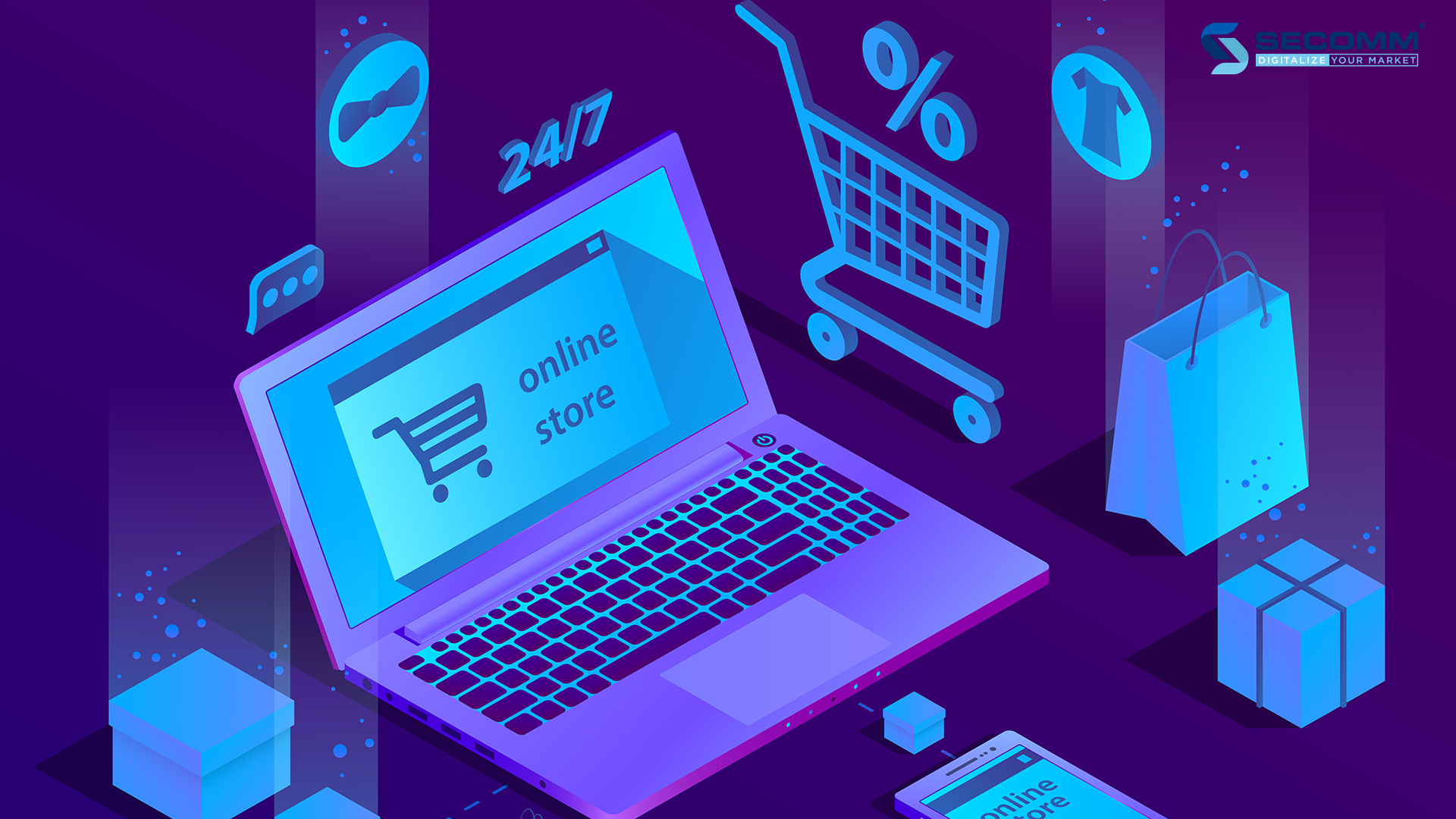
3 BARRIERS TO THE ECOMMERCE INDUSTRY IN VIETNAM
1. Quality of goods – one of the barriers to the ecommerce industry
The variety of products published on every ecommerce website is always diversity-guaranteed to meet almost the market needs. However, ensuring the criteria of goods quality has been an unresolved question up to now, becoming one of the barriers to the ecommerce industry. The burning issues of low-quality products, counterfeit consumer goods are eventually uncontrollable and exist in the market. Those effects can be derived from a couple of factors that can be analyzed from the perspective of the sellers, ecommerce enterprises, and consumers.
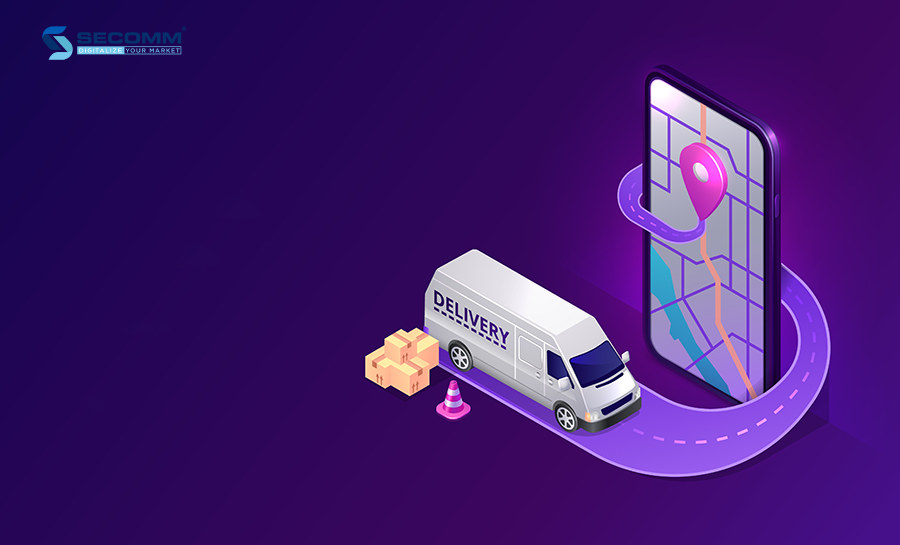
The seller’s consciousness
The low-quality of goods has come from the traditional trading model operated offline, and merchants inevitably take responsibility in that case. Although consumers can contemplate the offline model seriously, the product quality is still sellers’ responsibility and control. Uncontrollable-quality sources become a critical issue when merchants provide goods with a profitable price to get much higher returns by selling fake or inferior quality products with very attractively “low” prices. In the flourishing process of online business, those unsolved issues have the chance to spread across the online-offline frontier and lose control.
The perception of ecommerce enterprises
When the quality issue emerges, e-firms are the first to be impacted. Those types, namely B2C and C2C, act as middlemen for merchant support to sell products on ecommerce exchanges.
Consequently, those enterprises restrict the source of inferior products and entirely rely on consumer feedback to address the issue in a very passive way. The quality barrier prevents enterprises from gaining consumer trust to maintain their loyalty.
The buying awareness
The spread of low-quality goods partly comes from consumer awareness. In the e-market, there is still a consumer group preferring inexpensive or on-sales items to other high-price and authentic products to save the living cost or try a variety of products. They tend to choose low-price items neglecting the origin and information while never complaining about the lack of product-clarification. Low-awareness behavior gradually contributes to the growth of uncontrollable-inferior products and as a result, the development of barriers to the ecommerce industry.
The growth of poor quality products depends on many factors and the responsibility of sellers, businesses, and consumers for the sake of a healthy and trustworthy market.
2. Buying habits – one of the barriers to the ecommerce industry
The need to change buying behavior from offline to online is also one of the barriers to the ecommerce industry in Vietnam. To certainly clarify, take a look at three fundamental behavior-levels happenings when consumers make a purchase.

The first group is pure traditional shoppers, who tend to see and touch what to buy. They wholeheartedly believe their eye-process can ensure more quality and conformity of the product. Therefore, they never trust any online items because of unmanageable-value. As a consequence, changing the buying habit of this group is the most challenging requirement.
The second group is hybrid buyers combining traditional and modern buying styles. That hybrid group tends to select-for-best. For instance, they can quickly add a book or ten pens to their cart because it is more convenient than buying at the bookstore. However, they will directly go to a clothing store to choose an item that fits their size and ensure the fabric quality. That behavior similarly happens when they buy shoes, bags, or other fashion items. In brief, hybrid customers have changed their buying habits in the most popular fields over the years. Hence, there will be much higher requirements for unique products such as fashion items, technology devices, motorcycles, and cars in some cases.
The last group tends to complete online shopping. They take advantage of online shopping as a convenient and speedy tool, helping them save more time during the shopping process. However, this group still has some challenges: maintaining trust-worthy and credibility to upgrade target consumers to loyal customers.
While the increasing mobile-usage has somewhat raised the online shopping demand, the user-habit transformation is a worth-factor that needs better solutions in long-term strategies or it will be one of the barriers to the ecommerce industry. In particular, the significant element affecting ecommerce user-habit is the story of quality-expectation and the reliability of online stores.
3. Barriers to the ecommerce industry in Vietnam include long-term investment
Long-term productive resources in the ecommerce market are also one of the considerable barriers to the ecommerce industry. For this purpose, the ongoing need includes warehouse management, branding & marketing, payment & shipping processes. Consequently, all of the elements should require enterprises to keep the non-stop funding on continuous losses.
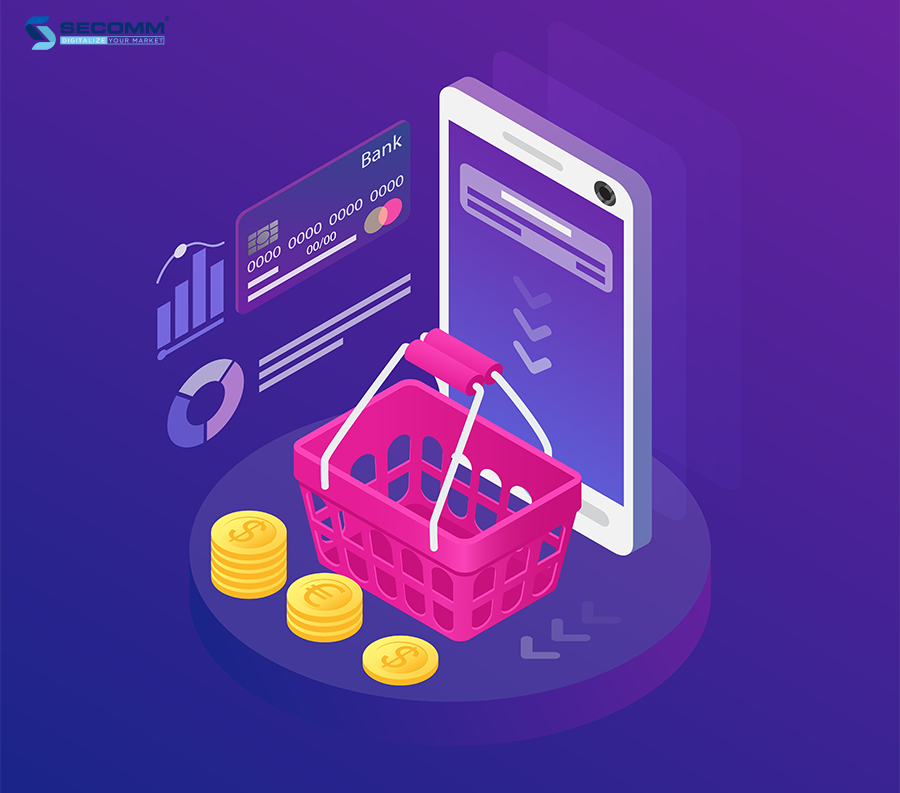
Along the same lines, small and medium-sized enterprises can not afford long-term competition versus the ecommerce giants in the market. For instance, international names like Alibaba, JD.com, or Amazon create an enormous distance for other SMEs to overtake.
In general, the capital investment race invisibly makes large ecommerce businesses more robust and extensive. Meanwhile, it oppositely generates more barriers to the ecommerce industry in Vietnam due to the lack of sufficient capital in the long term. Following this, depending on each organization, there will be many issues when operating an e-business. Therefore, it is necessary to have the most comprehensive outline and meticulous ecommerce study to set the oriented developing goals.
 2
2

 4,955
4,955

 0
0

 1
1

4 PLATFORMS FOR ECOMMERCE BUSINESSES IN VIETNAM
1. The developing process of ecommerce businesses in Vietnam
To discuss the establishment of ecommerce businesses in Vietnam, firstly, it is necessary to look at the development of the website systems. Years ago, the websites primarily displayed information on the Internet for easy access from audiences. Gradually, it has become a competent tool in creating brand identity, improving reliability, and supporting businesses to collect one-click testimonials from their visitors.
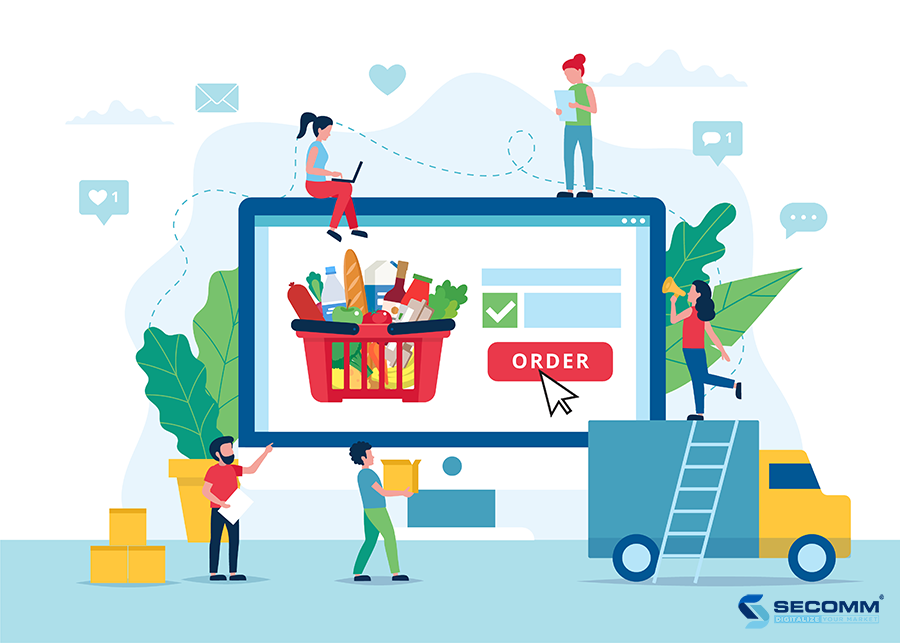
Over time, businesses want to increase productivity by selling products while saving costs and facilities. On the other hand, customers also need to buy products faster without directly going to the store. That is the reason leading to the birth of ecommerce.Today, the flash development of ecommerce allows businesses to easily access the market while increasing the opportunity to maximize user experience. In Vietnam, the ecommerce market has only been growing in recent years but has made a breakthrough with prominent brands like Shopee, Tiki, and Lazada.
2. Highly-recommended platforms should apply for ecommerce businesses in Vietnam
Magento
Magento has excellent functions, which highly create flexibility and adaptability, accommodating all sizes of ecommerce businesses in Vietnam. However, Magento is not very friendly for beginners. Instead, the platform has a massive range of features that are adaptive for almost the user-community.
Advantages
- Optimize search engines and security
- Include a variety of features supporting the sale and management of products
- Support multiple currencies, languages
- Integrate most of the payment gateways
- SEO-friendly
Disadvantages
- Only suitable for users having a basic understanding of code and web systems
- Require payments for extensions
Woocommerce
WooCommerce is not an autonomous platform to build an ecommerce website. It is a type of plugin running on WordPress. In other words, WooCommerce will optimize ecommerce functions for the website community based on the WordPress foundation. Thus, enterprises can start an online development plan in a more accessible and faster way.Utterly different from Magento, WooCommerce is more comfortable to use, especially suitable for beginners. Plus, it also possesses enough extensions handling almost basic tasks from product management to payment methods that can bring a website to the top ecommerce business in Vietnam.
Advantages
- Provide free editions
- Quickly access to extend features and customize the store
- Have strong support from a large user community
Disadvantages
- Advanced features often require extensions
- Extensions may need the other sub-extensions to support
Shopify
Pick up enormous scores from users; Shopify possesses the functions to integrate SEO, supporting the website system work, and customize fluidly. It also provides services based on the SaaS model with the main control center.
Advantages
- Convey a considerable range of themes that can be selected depending on each category
- Support users 24/7
- Integrate ads and payment gateways via Visa, Mastercard, and other payments
Disadvantages
- Require payment when using
- Request to use the available URLs
- Not support domestic payment gateways yet
- Not support Vietnamese yet (High-consideration if businesses plan to develop ecommerce businesses in Vietnam)
Haravan
Haravan is an open platform allowing easy website creation with similar characteristics to Shopify and WordPress. The platform possesses various features providing more conveniently supportive sales-management tools, especially the multi-channel sale on ecommerce websites, namely Lazada, Shopee, and Tiki.
Advantages
- Allow users to develop a variety of functions
- Have an inexpensive cost
- Support the Vietnamese language
Disadvantages
- Require payments when using some of the extensions
- Run as a local platform that is highly suitable for SMEs in Vietnam
3. Web design is the key to kick-off ecommerce businesses in Vietnam
The website system is a prerequisite to be maintained, updated regularly and continuously because it is the only interface connecting businesses and customers. For ecommerce businesses in Vietnam, designing a web system plays a crucial role in contributing to the success of an online business or its failure. This design phase is usually performed by the UI/UX team responsible for both visual and user experiences on the websites.

With the experience of developing ecommerce websites, SECOMM developers can apply most of the current platforms to meet our partners’ needs, especially ecommerce businesses in Vietnam. We always value the quality of our work and provide the most appropriate solutions to the occurring issues. Promptness, timeliness, and quality are the consistent goals that we always aim at in the process of operation.
 2
2

 1,842
1,842

 0
0

 1
1



